学生石墨烯文献翻译
石墨烯翻译2
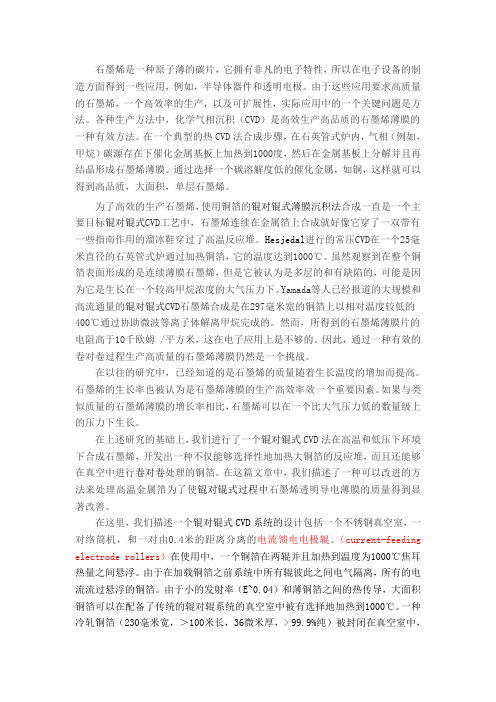
石墨烯是一种原子薄的碳片,它拥有非凡的电子特性,所以在电子设备的制造方面得到一些应用,例如,半导体器件和透明电极。
由于这些应用要求高质量的石墨烯,一个高效率的生产,以及可扩展性,实际应用中的一个关键问题是方法。
各种生产方法中,化学气相沉积(CVD)是高效生产高品质的石墨烯薄膜的一种有效方法。
在一个典型的热CVD法合成步骤,在石英管式炉内,气相(例如,甲烷)碳源存在下催化金属基板上加热到1000度,然后在金属基板上分解并且再结晶形成石墨烯薄膜。
通过选择一个碳溶解度低的催化金属,如铜,这样就可以得到高品质,大面积,单层石墨烯。
为了高效的生产石墨烯,使用铜箔的锟对锟式薄膜沉积法合成一直是一个主要目标锟对锟式CVD工艺中,石墨烯连续在金属箔上合成就好像它穿了一双带有一些指南作用的溜冰鞋穿过了高温反应堆。
Hesjedal进行的常压CVD在一个25毫米直径的石英管式炉通过加热铜箔,它的温度达到1000℃。
虽然观察到在整个铜箔表面形成的是连续薄膜石墨烯,但是它被认为是多层的和有缺陷的,可能是因为它是生长在一个较高甲烷浓度的大气压力下。
Yamada等人已经报道的大规模和高流通量的锟对锟式CVD石墨烯合成是在297毫米宽的铜箔上以相对温度较低的400℃通过协助微波等离子体解离甲烷完成的。
然而,所得到的石墨烯薄膜片的电阻高于10千欧姆 /平方米,这在电子应用上是不够的。
因此,通过一种有效的卷对卷过程生产高质量的石墨烯薄膜仍然是一个挑战。
在以往的研究中,已经知道的是石墨烯的质量随着生长温度的增加而提高。
石墨烯的生长率也被认为是石墨烯薄膜的生产高效率效一个重要因素。
如果与类似质量的石墨烯薄膜的增长率相比,石墨烯可以在一个比大气压力低的数量级上的压力下生长。
在上述研究的基础上,我们进行了一个锟对锟式CVD法在高温和低压下环境下合成石墨烯,开发出一种不仅能够选择性地加热大铜箔的反应堆,而且还能够在真空中进行卷对卷处理的铜箔。
石墨烯
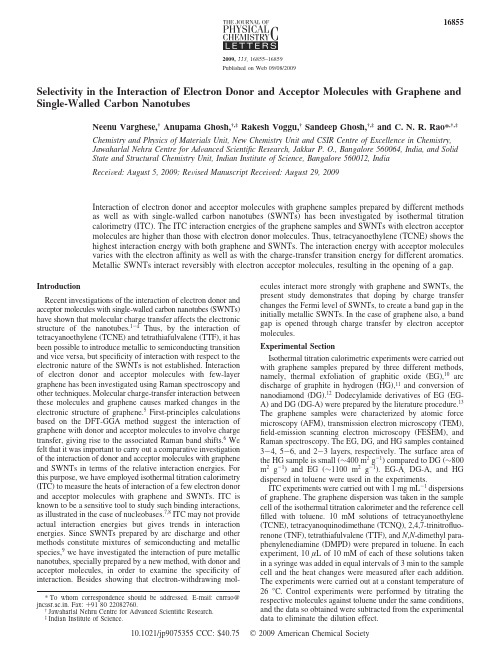
Selectivity in the Interaction of Electron Donor and Acceptor Molecules with Graphene and Single-Walled Carbon NanotubesNeenu Varghese,†Anupama Ghosh,†,‡Rakesh Voggu,†Sandeep Ghosh,†,‡and C.N.R.Rao*,†,‡Chemistry and Physics of Materials Unit,New Chemistry Unit and CSIR Centre of Excellence in Chemistry,Jawaharlal Nehru Centre for Ad V anced Scientific Research,Jakkur P.O.,Bangalore 560064,India,and Solid State and Structural Chemistry Unit,Indian Institute of Science,Bangalore 560012,India Recei V ed:August 5,2009;Re V ised Manuscript Recei V ed:August 29,2009Interaction of electron donor and acceptor molecules with graphene samples prepared by different methods as well as with single-walled carbon nanotubes (SWNTs)has been investigated by isothermal titration calorimetry (ITC).The ITC interaction energies of the graphene samples and SWNTs with electron acceptor molecules are higher than those with electron donor molecules.Thus,tetracyanoethylene (TCNE)shows the highest interaction energy with both graphene and SWNTs.The interaction energy with acceptor molecules varies with the electron affinity as well as with the charge-transfer transition energy for different aromatics.Metallic SWNTs interact reversibly with electron acceptor molecules,resulting in the opening of a gap.IntroductionRecent investigations of the interaction of electron donor and acceptor molecules with single-walled carbon nanotubes (SWNTs)have shown that molecular charge transfer affects the electronic structure of the nanotubes.1-4Thus,by the interaction of tetracyanoethylene (TCNE)and tetrathiafulvalene (TTF),it has been possible to introduce metallic to semiconducting transition and vice versa,but specificity of interaction with respect to the electronic nature of the SWNTs is not established.Interaction of electron donor and acceptor molecules with few-layer graphene has been investigated using Raman spectroscopy and other techniques.Molecular charge-transfer interaction between these molecules and graphene causes marked changes in the electronic structure of graphene.5First-principles calculations based on the DFT-GGA method suggest the interaction of graphene with donor and acceptor molecules to involve charge transfer,giving rise to the associated Raman band shifts.6We felt that it was important to carry out a comparative investigation of the interaction of donor and acceptor molecules with graphene and SWNTs in terms of the relative interaction energies.For this purpose,we have employed isothermal titration calorimetry (ITC)to measure the heats of interaction of a few electron donor and acceptor molecules with graphene and SWNTs.ITC is known to be a sensitive tool to study such binding interactions,as illustrated in the case of nucleobases.7,8ITC may not provide actual interaction energies but gives trends in interaction energies.Since SWNTs prepared by arc discharge and other methods constitute mixtures of semiconducting and metallic species,9we have investigated the interaction of pure metallic nanotubes,specially prepared by a new method,with donor and acceptor molecules,in order to examine the specificity of interaction.Besides showing that electron-withdrawing mol-ecules interact more strongly with graphene and SWNTs,the present study demonstrates that doping by charge transfer changes the Fermi level of SWNTs,to create a band gap in the initially metallic SWNTs.In the case of graphene also,a band gap is opened through charge transfer by electron acceptor molecules.Experimental SectionIsothermal titration calorimetric experiments were carried out with graphene samples prepared by three different methods,namely,thermal exfoliation of graphitic oxide (EG),10arc discharge of graphite in hydrogen (HG),11and conversion of nanodiamond (DG).12Dodecylamide derivatives of EG (EG-A)and DG (DG-A)were prepared by the literature procedure.13The graphene samples were characterized by atomic force microscopy (AFM),transmission electron microscopy (TEM),field-emission scanning electron microscopy (FESEM),and Raman spectroscopy.The EG,DG,and HG samples contained 3-4,5-6,and 2-3layers,respectively.The surface area of the HG sample is small (∼400m 2g -1)compared to DG (∼800m 2g -1)and EG (∼1100m 2g -1).EG-A ,DG-A,and HG dispersed in toluene were used in the experiments.ITC experiments were carried out with 1mg mL -1dispersions of graphene.The graphene dispersion was taken in the sample cell of the isothermal titration calorimeter and the reference cell filled with toluene.10mM solutions of tetracyanoethylene (TCNE),tetracyanoquinodimethane (TCNQ),2,4,7-trinitrofluo-renone (TNF),tetrathiafulvalene (TTF),and N ,N -dimethyl para-phenylenediamine (DMPD)were prepared in toluene.In each experiment,10µL of 10mM of each of these solutions taken in a syringe was added in equal intervals of 3min to the sample cell and the heat changes were measured after each addition.The experiments were carried out at a constant temperature of 26°C.Control experiments were performed by titrating the respective molecules against toluene under the same conditions,and the data so obtained were subtracted from the experimental data to eliminate the dilution effect.*To whom correspondence should be addressed.E-mail:cnrrao@jncasr.ac.in.Fax:+918022082760.†Jawaharlal Nehru Centre for Advanced Scientific Research.‡Indian Institute of Science.1685510.1021/jp9075355CCC:$40.752009American Chemical SocietyPublished on Web09/08/20092009,113,16855–16859SWNT samples were prepared by the arc discharge method and purified by successive acid and hydrogen treatment.14,15Metallic SWNTs were prepared by DC arc evaporation of a graphite rod containing the Ni +Y 2O 3catalyst,under a continuous flow of helium bubbled through Fe(CO)5.16The samples so obtained were nearly pure metallic SWNTs (around 95%).SWNT samples dispersed in o -dichlorobenzene (DCB)were sonicated for 1h to obtain 1mg mL -1solutions.Interaction of SWNTs with donor and acceptor molecules was studied in DCB solvent in the same manner as the graphene samples.In order to compare the results obtained with graphene and SWNTs,graphene samples (EG,EG-A,and HG)were also dispersed in DCB by sonication for 1h to obtain 1mg mL -1solutions.These solutions were used to study the interaction with TCNE.Results and DiscussionWe shall first discuss the results of ITC measurements on the interaction of graphenes with donor and acceptor molecules.Figure 1shows typical data obtained with 1.0mg mL -1solutions of EG-A in toluene with TCNE and TTF.Raw ITC data for the blank titration of 10mM TCNE and TTF against toluene are shown in Figure 1a and d.Figure 1b and e show the raw data for the titration of 10mM TCNE and TTF solutions against 1.0mg mL -1EG-A solution.The ITC response in the TCNE and TTF titrations against EG-A is exothermic,as shown in Figure 1b and e.In order to eliminate dilution effects,heats from the blank titration data were subtracted from the molecule -graphene titration data.Figure 1c and f show the integrated heat changes (enthalpy changes in kcal mol -1)aftereach injection of TCNE and TTF,respectively,after correcting for the heat of dilution.The exothermicity of the peaks reduces with progressive injection as the number of free sites for the binding of molecules available on the graphene decreases.The heat of reaction curve should ideally be sigmoidal in shape,but the limited solubility of graphene in toluene does not permit recording of the initial part of the sigmoidal curve.Absolute binding energies cannot therefore be obtained from the present data.The relative affinities of the different electron donor and acceptor molecules can,however,be estimated from the heat liberated in the initial injections,since all of the experiments were performed under similar conditions.The relative binding energies obtained from the initial points of the integrated heat plots in the case of EG-A and HG are listed in Table 1.The trend in the relative binding energies of electron acceptor molecules with EG-A obtained from ITC measurements isFigure 1.ITC data recorded for the interaction of TCNE and TTF with EG-A.ITC response for the blank titration with TCNE (a)and TTF (d).The raw ITC data for the titration of TCNE and TTF with 1.0mg mL -1of EG-A is shown in parts b and e.Parts c and f show the integrated heat of reaction at each injection of TCNE and TTF,respectively.TABLE 1:Energies of Interaction of Graphene and SWNTs with Electron Donor and Acceptor Molecules Obtained from ITC Measurements (in kcal mol -1)aEG-A bHG b SWNT c TCNE -5.88d -4.2-4.25TCNQ -0.24-0.32TNF -0.12-0.30-0.06DMPD -0.40-0.12-7.4e TTF-0.07-0.18aThe concentration of graphene and SWNTs was 1mg mL -1in all of the cases.b In toluene solvent.c In o -dichlorobenzene (DCB)solvent.d With DG-A,the value is -1.6.e This high value is due to interaction with the semiconducting SWNTs.16856J.Phys.Chem.C,Vol.113,No.39,2009LettersTCNE >TCNQ >TNF.Interaction energies of electron donor molecules with the graphene samples are considerably lower,the highest value being with N ,N -dimethyl para-phenylenedi-amine (DMPD).The interaction energy of TTF is lower than that of DMPD.In the case of the interaction of TCNE with the different graphene samples,the highest ITC interaction energy is found to be with EG-A (-5.9kcal mol -1)and the lowest with DG-A (-1.6kcal mol -1).It is noteworthy that the surface area of EG is highest among the graphene samples.17Interaction energies of graphene with different donor and acceptor molecules have been calculated by employing first-principles calculations using a linear combination of atomic orbital DFT methods implemented in the SIESTA package.6This study shows evidence for charge transfer between graphene and the donor and acceptor molecules.According to this study,the interaction energies of graphene with TCNE and TCNQ are greater than that with TTF.This is consistent with the results from our ITC studies.The calculations also show that a gap develops in the electronic structure of graphene on interaction with these molecules.We have obtained ITC interaction energies of SWNTs with donor and acceptor molecules by a procedure similar to that with graphene by using o -dichlorobenzene (DCB)as the solvent.Typical data obtained for 1.0mg mL -1solutions of SWNTs in DCB interacting with TCNE and TTF are given in Figure 2,the raw data for the blank titration of 10mM TCNE and TTF against DCB being shown in Figure 2a and d,respectively.Raw data for the titration of 10mM TCNE and TTF solutions against the 1.0mg mL -1SWNT solution are given in Figure 2b and e.The ITC response in the titrations is exothermic,as revealed by Figure 2b and e.The integrated heat changes after each injection of TCNE and TTF,respectively (after correcting for the heat of dilution),are shown in Figure 2c and f.Just as in the case of graphene,exothermicity of the peaks reduces with progressive injection.The energies of interaction calculated from the initial points of the integrated heat plots are listed in Table 1.It is interesting that,for electron acceptor molecules,the trend in the ITC interaction energies with SWNTs is the same as that with graphene (TCNE >TCNQ >TNF).Among the donor molecules,DMPD shows a higher interaction energy than TTF.Since the data for SWNTs were obtained in DCB solvent,we wanted to compare the data of graphenes in the same solvent.The relative interaction energies of TCNE in DCB solvent are -1.4,-0.7,and -0.6kcal mol -1with EG-A,EG,and HG,respectively,giving the trend EG-A >EG >HG.This trend parallels that of the surface area.The interaction energy of SWNTs (-4.3kcal mol -1)with TCNE is generally larger than that for the graphene samples.First-principles calculations of Pati in this laboratory (personal communication)has shown the interaction energy of SWNTs with TCNQ to be greater than that with TTF.SWNTs exhibit a higher interaction energy than graphene.Interaction energies of graphene as well as SWNTs with electron acceptor molecules increase progressively with the electron affinities of the acceptors,as can be seen in Figure 3a.18This result confirms that charge transfer between the acceptor molecules and graphene or SWNTs contributes sig-nificantly to the interaction energy.Indirect confirmation of this conclusion is also provided by the fact that the interaction energy varies systematically with the charge-transfer transition energy,Figure 2.ITC data recorded for the interaction of TCNE and TTF with SWNTs.ITC response for the blank titration with TCNE (a)and TTF (d).The raw ITC data for the titration of TCNE and TTF with 1.0mg mL -1of SWNT is shown in parts b and e.Parts c and f show the integrated heat of reaction at each injection for TCNE and TTF,respectively.Letters J.Phys.Chem.C,Vol.113,No.39,200916857hυCT,of the acceptors with an aromatic such as anthracene,19-21 as shown in Figure3b.SWNTs prepared by arc-discharge and other methods contain a mixture of metallic and semiconducting species,9the propor-tion of semiconducting nanotubes being around66%.The interaction energies that we have given in Table1correspond to the mixture of metallic and semiconducting SWNTs.It would be more instructive if one were able to determine the interaction energy between the donor and acceptor molecules with pure metallic or semiconducting nanotubes.ITC measurements on the interaction of metallic SWNTs with donor and acceptor molecules reveal the interaction energy to be high in the case of TCNE(-7.4kcal mol-1),the energy varying in the order TCNE>TNF>TCNQ in the case of the acceptor molecules (Table2).Interaction energies of acceptor molecules with metallic SWNTs are generally higher than those with the as-prepared SWNTs(containing the mixture of metallic and semiconducting species).The interaction energy of metallic nanotubes with a donor molecule such as TTF is negligible and could not be measured by ITC.This result shows that metallic nanotubes specifically interact with electron-withdrawing mol-ecules.In order to understand the nature of this interaction,we examined the effect of acceptor and donor molecules on the Raman spectrum of metallic SWNTs.In Figure4,we show the Raman G-band of metallic nanotubes before and after the interaction with TCNE(10mM).On interaction with TCNE, the feature around1540cm-1due to the metallic species1,22disappears completely and the band maximum shifts to1582 cm-1.This change in the Raman spectrum corresponds to the opening of a gap due to a change in the Fermi level of SWNTs, giving rise to an apparent metal-semiconductor transition. Electron-donating molecules have no effect on the Raman spectrum of metallic SWNTs.First-principles calculations also show that metallic(9,0)SWNTs develop a gap on interaction with TCNE.Electron-donating molecules,however,specifically interact with semiconducting nanotubes.Raman spectra show that semiconducting SWNTs exhibit an intense metallic feature in the1540cm-1region on interaction with TTF. ConclusionsIn conclusion,ITC provides a satisfactory means to investi-gate the interaction of graphene as well as SWNTs with electron donor and acceptor molecules.Although ITC does not provide absolute interaction energies,it gives trends in interaction energy which are of value.Interaction energies of electron acceptor molecules(TCNE,TCNQ,and TNF)with graphene samples are higher than those of electron donor molecules(TTF and DMPD).Among the different graphene samples,the function-alized graphene EG-A shows the highest interaction energy.The studies carried out by us are on few-layer graphenes,but it would be somewhat difficult to investigate single-layer graphenes in this manner owing to its agglomeration in solid state.Interaction energies of SWNTs obtained from ITC are generally higher than those with graphene samples.Here again,TCNE gives the highest interaction energy.Metallic SWNTs interact reversibly with electron acceptor molecules,such as TCNE,the interaction energy being higher than with as-prepared SWNTs(containing a mixture of metallic and semiconducting species).On interac-tion of metallic SWNTs with TCNE,the metallic feature in the Raman G-band disappears,due to the opening of a gap through molecular charge transfer.It would be worthwhile to study the interaction of pure semiconducting SWNTs with donor and acceptor molecules by a combined use of ITC Raman spectroscopy.Figure3.Variation of interaction energies of EG-A and SWNTs with electron acceptors(a)with the electron affinity of acceptors,E A,and (b)with the charge-transfer transition energy,hυCT,with anthracene (EG-A,squares;SWNTs,circles;metallic SWNTs,triangles).TABLE2:Energies of Interaction of SWNTs with Electron Donor and Acceptor Molecules Obtained from ITC Measurements(in kcal mol-1)aSWNT b metallic SWNT TCNE-4.25-7.4TCNQ-0.32-0.64TNF-0.06-0.80TTF-0.18+0.07a The concentration of SWNTs was1mg mL-1in DCB solvent in all of the cases.b Mixture containing66%semiconducting and 33%metallic SWNTs.Figure4.Raman G-band of(a)metallic SWNTs and(b)metallic SWNTs after interaction with TCNE(10mM).16858J.Phys.Chem.C,Vol.113,No.39,2009LettersAcknowledgment.We thank indaraj for help with the preparation of SWNTs.References and Notes(1)Voggu,R.;Rout,C.S.;Franklin,A.D.;Fisher,T.S.;Rao,C.N.R. J.Phys.Chem.C2008,112,13053–13056.(2)Shin,H.J.;Kim,S.M.;Yoon,S.M.;Benayad,A.;Kim,K.K.; Kim,S.J.;Park,H.K.;Choi,J.Y.;Lee,Y.H.J.Am.Chem.Soc.2008, 130,2062–2066.(3)Tournus,F.;Latil,S.;Heggie,M.I.;Charlier,J.C.Phys.Re V.B 2005,72,075431(1-5).(4)Strano,M.S.;Dyke,C.A.;Usrey,M.L.;Barone,P.W.;Allen, M.J.;Shan,H.;Kittrell,C.;Hauge,R.H.;Tour,J.M.;Smalley,R.E. Science2003,301,1519–1522.(5)Das,B.;Voggu,R.;Rout,C.S.;Rao,mun. 2008,5155–5157.Voggu,R.;Das,B.;Rout,C.S.;Rao,C.N.R.J.Phys.: Condens.Matter2008,20,472204(1-5).(6)Manna,A.K.;Pati,S.K.Chem.s Asian J.2009,4,855–860.(7)Ladbury,J.E.;Chowdhry,B.Z.Chem.Biol.1996,3,791–801.(8)Das,A.;Sood,A.K.;Maiti,P.K.;Das,M.;Varadarajan,R.;Rao,C.N.R.Chem.Phys.Lett.2008,453,266–273.Varghese,N.;Mogera, U.;Govindaraj,A.;Das,A.;Maiti,P.K.;Sood,A.K.;Rao,C.N.R. ChemPhysChem2008,10,206–210.(9)Rao,C.N.R.;Govindaraj,A.Nanotubes and Nanowires;RSC Nanoscience&Nanotechnology series;Royal Society of Chemistry: Cambridge,U.K.,2005.(10)Schniepp,H.C.;Li,J.L.;McAllister,M.J.;Sai,H.;Herrera-Alonso,M.;Adamson,D.H.;Prud’homme,R.K.;Car,R.;Saville,D.A.; Aksay,I.A.J.Phys.Chem.B2006,110,8535–8539.(11)Subrahmanyam,K.S.;Panchakarla,L.S.;Govindaraj,A.;Rao,C.N.R.J.Phys.Chem.C2009,113,4257–4259.(12)Andersson,O.E.;Prasad,B.L.V.;Sato,H.;Enoki,T.;Hishiyama, Y.;Kaburagi,Y.;Yoshikawa,M.;Bandow,S.Phys.Re V.B1998,58, 16387–16395.(13)Subrahmanyam,K.S.;Vivekchand,S.R.C.;Govindaraj,A.;Rao,C.N.R.J.Mater.Chem.2008,18,1517–1523.Rao,C.N.R.;Biswas,K.; Subrahmanyam,K.S.;Govindaraj,A.J.Mater.Chem.2009,19,2457–2469.(14)Journet,C.;Maser,W.K.;Bernier,P.;Loiseau,A.;Lamy de la Chapelle,M.;Lefrant,S.;Deniard,P.;Lee,R.;Fischer,J.E.Nature1997, 388,756–758.(15)Vivekchand,S.R.C.;Govindaraj,A.;Sheikh,M.M.;Rao,C.N.R. J.Phys.Chem.B2004,108,6935–6937.(16)Voggu,R.;Govindaraj,A.;Rao,C.N.R.Condens.Matter2009, arXiv:0903.5359v1.Voggu,R.;Ghosh,S.;Govindaraj,A.;Rao,C.N.R. J.Nanosci.Nanotechnol,in press.(17)Subrahmanyam,K.S.;Voggu,R.;Govindaraj,A.;Rao,C.N.R. Chem.Phys.Lett.2009,472,96–98.(18)Briegleb,G.Angew.Chem.,Int.Ed.1964,3,617–632.(19)Dewar,M.J.S.;Rogers,H.J.Am.Chem.Soc.1962,84,395–398.(20)Acker,D.S.;Hertler,W.R.J.Am.Chem.Soc.1962,84,3370–3374.(21)Lepley,A.R.J.Am.Chem.Soc.1962,84,3577–3588.(22)Das,A.;Sood,A.K.;Govindaraj,A.;Saitta,A.M.;Lazzeri,M.; Mauri,F.;Rao,C.N.R.Phys.Re V.Lett.2007,99,136803(1-4).JP9075355Letters J.Phys.Chem.C,Vol.113,No.39,200916859。
石墨烯光学性质以及二维材料的纳米光子学性质浅析

使光集中用于等离子体共振,从而使局部电场得到显著增强。在量子效 率方面得到巨大提高。但也会导致可操作宽带的范围减少。
② 整合量子点和石墨烯
用胶体量子点覆盖石墨烯可以获得具有能够获得具有 108 电子/光子的的超高光电探测和 107AW-1 的光响应的光电探测器。但由于需要长时间产生增益, 它们的运算速度也很低。
石墨烯等离激元学
由于石墨烯同时具有高的载流子迁移率和高导电性,它也成为了一种极具前 景的太赫兹到中红外等离子体器件应用的候选材料。等离子体具有高局域场 强度,广泛用于包括光学天线,近场光学显微镜,化学和生物传感器和亚波 长光学器件等。和传统等离子材料相比具有以下优点: ① 可以通过化学掺杂和门电压调控。 ② 具有更强的局域性 ③ 低损耗和长寿命 ④ 结晶度
过渡金属二硫化物光子学
过渡金属二硫化物(TMDCs)是化学公式为MX2的材料,M代表Mo、W、Nb、Re 这一类元素,X是硫元素。
TMDCs的层间相互作用是弱范德华力,而平面成键是强共价键。因此TMDCs 可以被剥离到类似石墨烯的薄膜结构,显著地扩展了二维材料的材料库。一 些二维的TMDCs,如钼和钨的硫化物,在多层的形式中有间接带隙,而在它们 的单层形式中成为直接带隙半导体。他们相当大的和可调带隙,不仅仅能产 生强的光致发光,也能打开像光电探测器,能量收集器,电致发光等光电器 件的大门。而且不同于石墨烯基器件,他具有可操作的光谱范围。另外,在 一些二维的TMDCs中已经证明了的奇异光学性质,如谷相干和谷选择性的圆二 色性,使这些材料非常有希望发现新的物理现象。
① 光与石墨烯的相互作用从能带跃迁的角度主要有两种:带间跃迁和带内跃 迁。远红外和太赫兹光谱区为带内跃迁,近红外及可见光光谱区主要是带 间跃迁;
石墨烯外国文献翻译
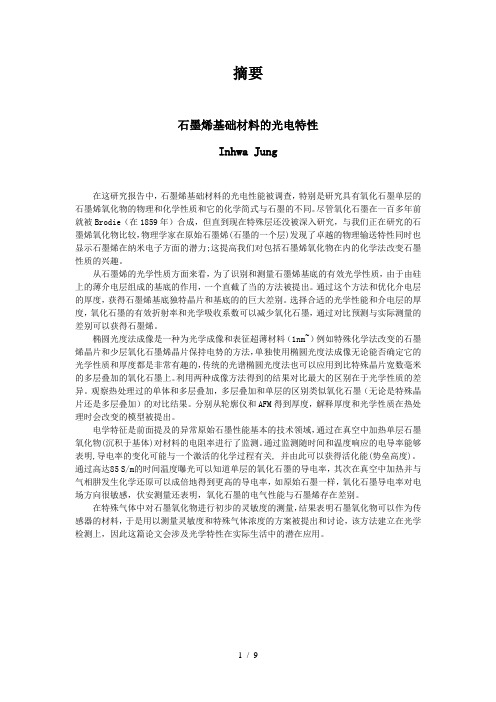
石墨烯基础材料的光电特性Inhwa Jung在这研究报告中,石墨烯基础材料的光电性能被调查,特别是研究具有氧化石墨单层的石墨烯氧化物的物理和化学性质和它的化学简式与石墨的不同。
尽管氧化石墨在一百多年前就被Brodie(在1859年)合成,但直到现在特殊层还没被深入研究,与我们正在研究的石墨烯氧化物比较,物理学家在原始石墨烯(石墨的一个层)发现了卓越的物理输送特性同时也显示石墨烯在纳米电子方面的潜力;这提高我们对包括石墨烯氧化物在内的化学法改变石墨性质的兴趣。
从石墨烯的光学性质方面来看,为了识别和测量石墨烯基底的有效光学性质,由于由硅上的薄介电层组成的基底的作用,一个直截了当的方法被提出。
通过这个方法和优化介电层的厚度,获得石墨烯基底独特晶片和基底的的巨大差别。
选择合适的光学性能和介电层的厚度,氧化石墨的有效折射率和光学吸收系数可以减少氧化石墨,通过对比预测与实际测量的差别可以获得石墨烯。
椭圆光度法成像是一种为光学成像和表征超薄材料(1nm~)例如特殊化学法改变的石墨烯晶片和少层氧化石墨烯晶片保持电势的方法,单独使用椭圆光度法成像无论能否确定它的光学性质和厚度都是非常有趣的,传统的光谱椭圆光度法也可以应用到比特殊晶片宽数毫米的多层叠加的氧化石墨上。
利用两种成像方法得到的结果对比最大的区别在于光学性质的差异。
观察热处理过的单体和多层叠加,多层叠加和单层的区别类似氧化石墨(无论是特殊晶片还是多层叠加)的对比结果。
分别从轮廓仪和AFM得到厚度,解释厚度和光学性质在热处理时会改变的模型被提出。
电学特征是前面提及的异常原始石墨性能基本的技术领域,通过在真空中加热单层石墨氧化物(沉积于基体)对材料的电阻率进行了监测。
通过监测随时间和温度响应的电导率能够表明,导电率的变化可能与一个激活的化学过程有关, 并由此可以获得活化能(势垒高度)。
通过高达85 S/m的时间温度曝光可以知道单层的氧化石墨的导电率,其次在真空中加热并与气相肼发生化学还原可以成倍地得到更高的导电率,如原始石墨一样,氧化石墨导电率对电场方向很敏感,伏安测量还表明,氧化石墨的电气性能与石墨烯存在差别。
“Graphene”研究及翻译

“Graphene”研究及翻译摘要:查阅近5年我国SCI、EI期源刊有关石墨烯研究873篇,石墨烯研究的有关翻译存在很大差异。
从石墨烯的发现史及简介,谈石墨烯内涵及研究的相关翻译。
指出“石墨烯”有关术语翻译、英文题目、摘要撰写应注意的问题。
关键词:石墨烯;石墨烯术语;翻译石墨烯是目前发现的唯一存在的二维自由态原子晶体,它是构筑零维富勒烯、一维碳纳米管、三维体相石墨等sp2杂化碳的基本结构单元,具有很多奇异的电子及机械性能。
因而吸引了化学、材料等其他领域科学家的高度关注。
近5年我国SCI、EI期源刊研究论文873篇,论文质量良莠不齐,发表的论文有35.97%尚未被引用过,占国际论文被引的4.84%左右。
石墨烯研究的有关翻译也存在很大差异。
为了更好的进行国际学术交流,规范化专业术语。
本文就“graphene”的内涵及翻译谈以下看法。
l “Graphene”的发现史及简介1962年,Boehm等人在电镜上观察到了数层甚至单层石墨(氧化物)的存在,1975年van Bom-mel等人报道少层石墨片的外延生长研究,1999年德克萨斯大学奥斯汀分校的R Ruoff等人对用透明胶带从块体石墨剥离薄层石墨片的尝试进行相关报道。
2004年曼彻斯特大学的Novoselov和Geim小组以石墨为原料,通过微机械力剥离法得到一系列叫作二维原子晶体的新材料——石墨烯,并于10月22日在Sclence期刊上发表有关少层乃至单层石墨片的独特电学性质的文章,2010年Gelm和No-voselov获得了诺贝尔物理学奖。
石墨烯有着巨大的比表面积(2630 m2/g)、极高的杨氏模量(1.06 TPa)和断裂应力(~130GPa)、超高电导率(~106 S/cm)和热导率(5000W/m·K)。
石墨烯中的载流子迁移率远高于传统的硅材料,室温下载流子的本征迁移率高达200000 cm2/V.s),而典型的硅场效应晶体管的电子迁移率仅约1000 cm2/V.s。
毕业论文外文翻译-负载银的掺氮石墨烯概论
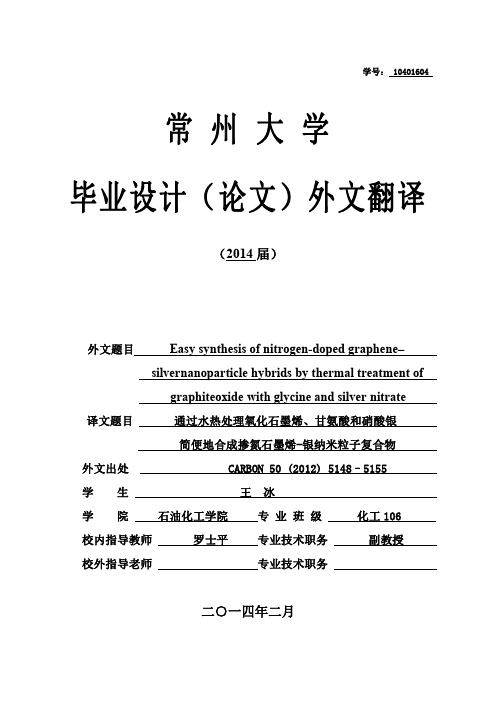
学号:10401604常州大学毕业设计(论文)外文翻译(2014届)外文题目Easy synthesis of nitrogen-doped graphene–silvernanoparticle hybrids by thermal treatment ofgraphiteoxide with glycine and silver nitrate 译文题目通过水热处理氧化石墨烯、甘氨酸和硝酸银简便地合成掺氮石墨烯-银纳米粒子复合物外文出处CARBON50(2012)5148–5155学生王冰学院石油化工学院专业班级化工106校内指导教师罗士平专业技术职务副教授校外指导老师专业技术职务二○一四年二月通过水热处理氧化石墨烯、甘氨酸和硝酸银简便地合成氮杂石墨烯-银纳米粒子杂合物Sundar Mayavan,Jun-Bo Sim,Sung-Min Choi摘要:氮杂石墨烯-银纳米粒子杂合物在500℃通过水热处理氧化石墨烯(GO)、甘氨酸和硝酸银制得。
甘氨酸用于还原硝酸根离子,甘氨酸和硝酸根混合物在大约200℃分解。
分解的产物可作为掺杂氮的来源。
水热处理GO、甘氨酸和硝酸银混合物在100℃可形成银纳米粒子,200℃时GO还原,300℃时产生吡咯型掺氮石墨烯,500℃时生成吡咯型掺氮石墨烯。
合成物质中氮原子所占百分比为13.5%.在合成各种纳米金属粒子修饰的氮杂石墨烯方面,该合成方法可能开辟了一个新的路径,其在能量储存和能量转换设备方面很有应用价值。
1.引言石墨烯是所有石墨材料的基本构件,其蜂窝状晶格由单层碳原子排列而成。
它表现出与结构有关的独特电子、机械和化学性质,具有较高的比表面积(2630-2965m2g-1)[1–3]。
化学掺杂杂原子石墨烯像掺杂氮原子,极大地引起了人们的兴趣,因其在传感器、燃料电池的催化剂和锂离子电池的电极等方面具有应用潜力[4–6]。
氮原子的掺杂改变了石墨烯的电子特性和结构特性,导致其电子移动性更强,产生更多的表面缺位。
Layer-by-Layer Assembly of Ultrathin Composite Films
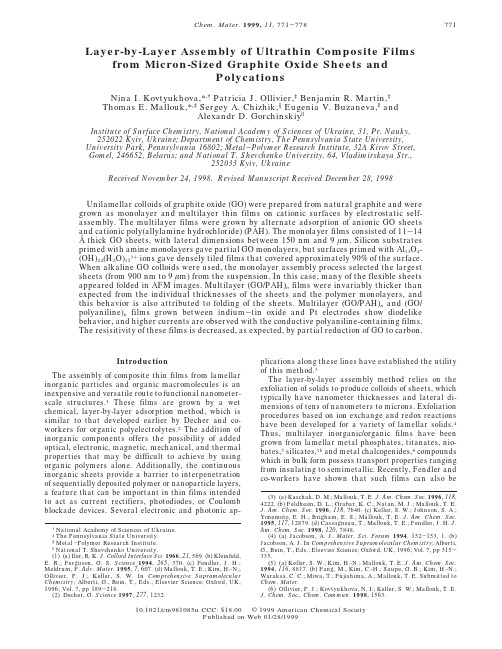
Layer-by-Layer Assembly of Ultrathin Composite Films from Micron-Sized Graphite Oxide Sheets andPolycationsNina I.Kovtyukhova,*,†Patricia J.Ollivier,‡Benjamin R.Martin,‡Thomas E.Mallouk,*,‡Sergey A.Chizhik,§Eugenia V.Buzaneva,|andAlexandr D.Gorchinskiy|Institute of Surface Chemistry,National Academy of Sciences of Ukraine,31,Pr.Nauky, 252022Kyiv,Ukraine;Department of Chemistry,The Pennsylvania State University, University Park,Pennsylvania16802;Metal-Polymer Research Institute,32A Kirov Street, Gomel,246652,Belarus;and National T.Shevchenko University,64,Vladimirskaya Str.,252033Kyiv,UkraineReceived November24,1998.Revised Manuscript Received December28,1998Unilamellar colloids of graphite oxide(GO)were prepared from natural graphite and were grown as monolayer and multilayer thin films on cationic surfaces by electrostatic self-assembly.The multilayer films were grown by alternate adsorption of anionic GO sheets and cationic poly(allylamine hydrochloride)(PAH).The monolayer films consisted of11-14Åthick GO sheets,with lateral dimensions between150nm and9µm.Silicon substrates primed with amine monolayers gave partial GO monolayers,but surfaces primed with Al13O4-(OH)24(H2O)127+ions gave densely tiled films that covered approximately90%of the surface. When alkaline GO colloids were used,the monolayer assembly process selected the largest sheets(from900nm to9µm)from the suspension.In this case,many of the flexible sheets appeared folded in AFM images.Multilayer(GO/PAH)n films were invariably thicker than expected from the individual thicknesses of the sheets and the polymer monolayers,and this behavior is also attributed to folding of the sheets.Multilayer(GO/PAH)n and(GO/ polyaniline)n films grown between indium-tin oxide and Pt electrodes show diodelike behavior,and higher currents are observed with the conductive polyaniline-containing films. The resisitivity of these films is decreased,as expected,by partial reduction of GO to carbon.IntroductionThe assembly of composite thin films from lamellar inorganic particles and organic macromolecules is an inexpensive and versatile route to functional nanometer-scale structures.1These films are grown by a wet chemical,layer-by-layer adsorption method,which is similar to that developed earlier by Decher and co-workers for organic polyelectrolytes.2The addition of inorganic components offers the possibility of added optical,electronic,magnetic,mechanical,and thermal properties that may be difficult to achieve by using organic polymers alone.Additionally,the continuous inorganic sheets provide a barrier to interpenetration of sequentially deposited polymer or nanoparticle layers, a feature that can be important in thin films intended to act as current rectifiers,photodiodes,or Coulomb blockade devices.Several electronic and photonic ap-plications along these lines have established the utility of this method.3The layer-by-layer assembly method relies on the exfoliation of solids to produce colloids of sheets,which typically have nanometer thicknesses and lateral di-mensions of tens of nanometers to microns.Exfoliation procedures based on ion exchange and redox reactions have been developed for a variety of lamellar solids.4 Thus,multilayer inorganic/organic films have been grown from lamellar metal phosphates,titanates,nio-bates,5silicates,1b and metal chalcogenides,6compounds which in bulk form possess transport properties ranging from insulating to semimetallic.Recently,Fendler and co-workers have shown that such films can also be†National Academy of Sciences of Ukraine.‡The Pennsylvania State University.§Metal-Polymer Research Institute.|National T.Shevchenko University.(1)(a)Iler,R.K.J.Colloid Interface Sci.1966,21,569.(b)Kleinfeld,E.R.;Ferguson,G.S.Science1994,265,370.(c)Fendler,J.H.; Meldrum,F.Adv.Mater.1995,7,607.(d)Mallouk,T.E.;Kim,H.-N.; Ollivier,P.J.;Keller,S.W.In Comprehensive Supramolecular Chemistry;Alberti,G.,Bein,T.,Eds.;Elsevier Science;Oxford,UK, 1996;Vol.7,pp189-218.(2)Decher,G.Science1997,277,1232.(3)(a)Kaschak,D.M.;Mallouk,T.E.J.Am.Chem.Soc.1996,118, 4222.(b)Feldheim,D.L.;Grabar,K.C.;Natan,M.J.;Mallouk,T.E. J.Am.Chem.Soc.1996,118,7640.(c)Keller,S.W.;Johnson,S.A.; Yonemoto,E.H.;Brigham,E.S.;Mallouk,T.E.J.Am.Chem.Soc. 1995,117,12879.(d)Cassagneau,T.;Mallouk,T.E.;Fendler,J.H.J. Am.Chem.Soc.1998,120,7848.(4)(a)Jacobson,A.J.Mater.Sci.Forum1994,152-153,1.(b) Jacobson,A.J.In Comprehensive Supramolecular Chemistry;Alberti, G.,Bein,T.,Eds.;Elsevier Science;Oxford,UK,1996;Vol.7,pp315-335.(5)(a)Keller,S.W.;Kim,H.-N.;Mallouk,T.E.J.Am.Chem.Soc. 1994,116,8817.(b)Fang,M.,Kim,C.-H.;Saupe,G.B.;Kim,H.-N.; Waraksa,C.C.;Miwa,T.;Fujishima,A.;Mallouk,T.E.Submitted to Chem.Mater.(6)Ollivier,P.J.;Kovtyukhova,N.I.;Keller,S.W.;Mallouk,T.E. J.Chem.Soc.,mun.1998,1563.771Chem.Mater.1999,11,771-77810.1021/cm981085u CCC:$18.00©1999American Chemical SocietyPublished on Web01/28/1999grown from graphite oxide(GO),7which can subse-quently be reduced electrochemically to make electroni-cally conducting graphitic films.In their work,GO nanoparticles were prepared from synthetic graphite. They noted that the multilayer films consisted of incompletely exfoliated platelets that were tens of nanometers in their lateral dimensions.In this paper, we revisit the assembly of GO/polycation thin films, using GO prepared from natural crystals.We show that exfoliated GO derived from these crystals is a mechani-cally robust material that deposits conformally on cationic surfaces as micron-sized,nanometer-thick sheets. Graphite oxide is a pseudo-two-dimensional solid in bulk form,with strong covalent bonding within the layers.Weak interlayer contacts are made by hydrogen bonds between intercalated water molecules.8-11The carbon sheets in GO contain embedded hydroxyl and carbonyl groups,as well as carboxyl groups situated mainly at the edges of the sheets.8,9,12While there is no consensus as to the precise structure of GO layers, different structural models,9a,b,10which correspond to an ideal formula of C8O2(OH)2,have been advanced.A recent study of the structure of GO argues from13C and 1H NMR evidence for the presence of epoxy groups.13 Nakajima and co-workers have proposed that the carbon layers in GO are linked together in pairs by sp3C-C bonds perpendicular to the sheets.10According to Kli-nowski et al.,13the carbon layers in GO contain two kinds of domains,aromatic regions with unoxidized benzene rings and aliphatic regions with six-membered carbon rings.The relative size of the domains,which are randomly distributed,depends on the degree of oxidation.In both models,the hydroxyl groups project above and below the carbon grid.The phenolic hydroxyl groups are acidic and,together with the carboxyl groups, are responsible for the negative charge on the GO sheets in aqueous suspensions.9,13The surface charge density of colloidal GO particles(degree of oxidation85%)was measured by Fendler and co-workers as0.4per100Å2.7 The GO interlayer distance is not constant and depends strongly on the GO:H2O ratio.8-10,15In very dilute aqueous suspensions,the interlayer distance is large,so interaction between the layers is sufficiently weak that exfoliation occurs.8Our previous research showed that the number of layers in the GO colloidal particles can be controlled by the dilution of the suspen-sions.16,17The adsorption capacity for Cu(II)ions,which was for both aqueous suspensions16and thin films deposited from these suspensions on powder supports (ZnO,Al2O3,fumed SiO2),17increased with decreasing GO concentration in the starting suspension.For ex-ample,the adsorption capacity of GO films on SiO2 increased by a factor of2.4when the GO concentration in the starting suspension was decreased from1.0to 0.3g/L.This result shows that more complete exfoliation provides increased access to the GO functional groups. For samples prepared from the colloids with GO con-centrations of0.02-0.3g/L,the maximum adsorption capacity,22-24mmol/g,was obtained.This value is close to the total quantity of oxygen-containing groups in GO(25mmol/g9)and gives indirect evidence that dilute GO colloids are exfoliated as monolayers.We report here a detailed study of the preparation and characterization of GO/polycation films grown on planar Si and Al2O3/Al ing atomic force microscopy(AFM),ellipsometry,and electrical mea-surements,the following questions have been addressed: What does the first layer of the sheets adsorbed on a substrate look like microscopically?Can we affect the quality of mono-and multilayer films by varying the conditions of their deposition and the chemical composition of the substrate surface? What are the electronic properties of GO/polycation films,and how are they influenced by the nature of the polycation?Experimental SectionMaterials.GO was synthesized from natural graphite powder(325mesh,GAK-2,Ukraine)by the method of Hum-mers and Offeman.18It was found that,prior to the GO preparation according to ref18,an additional graphite oxida-tion procedure was needed.Otherwise,incompletely oxidized graphite-core/GO-shell particles were always observed in the final product.The graphite powder(20g)was put into an80°C solution of concentrated H2SO4(30mL),K2S2O8(10g),and P2O5(10g).The resultant dark blue mixture was thermally isolated and allowed to cool to room temperature over a period of6h.The mixture was then carefully diluted with distilled water,filtered,and washed on the filter until the rinse water pH became neutral.The product was dried in air at ambient temperature overnight.This preoxidized graphite was then subjected to oxidation by Hummers’method.The oxidized graphite powder(20g)was put into cold(0°C)concentrated H2SO4(460mL).KMnO4(60g)was added gradually with stirring and cooling,so that the temperature of the mixture was not allowed to reach20°C.The mixture was then stirred at35°C for2h,and distilled water(920mL)was added.In 15min,the reaction was terminated by the addition of a large amount of distilled water(2.8L)and30%H2O2solution(50 mL),after which the color of the mixture changed to bright yellow.The mixture was filtered and washed with1:10HCl solution(5L)in order to remove metal ions.The GO product was suspended in distilled water to give a viscous,brown,2% dispersion,which was subjected to dialysis to completely remove metal ions and acids.The resulting0.5%w/v GO dispersion,which is stable for a period of years,was used to prepare exfoliated GO.Exfoliation was achieved by dilution of the0.5%GO disper-sion(1mL)with deionized water(24mL),followed by15min sonication.The resulting homogeneous yellow-brown sol, which contained0.2g/L GO,was stable for a period of months and was used for film preparation.An aqueous solution(0.01M)of poly(allylamine hydrochlo-ride),PAH,(Aldrich,MW)50000-65000)was adjusted to pH7with NH3and was used for growth of polycation layers.(7)(a)Kotov,N.A.;Dekany,I.;Fendler,J.H.Adv.Mater.1996,8,637.(b)Cassagneau,T.;Fendler,J.H.Adv.Mater.1998,10,877.(8)(a)Thiele,H.Kolloid-Z1948,111,15.(b)Croft,R.C.Quart.Rev.1960,14,1.(9)(a)Scholz,W.;Boehm,H.P.Z.Anorg.Allg.Chem.1969,369,327.(b)Clauss,A.;Boehm,H.P.;Hofmann,U.Z.Anorg.Allg.Chem.1957,291,205.(10)Nakajima,T.;Mabuchi,A.;Hagiwara,R.Carbon1988,26,357.(11)Karpenko,G.;Turov,V.;Kovtyukhova,N.;Bakai,E.;Chuiko,A.Theor.Exp.Chem.(Russ.)1990,1,102.(12)Hadzi,D.;Novak,A.Trans.Faraday.Soc.1955,51,1614.(13)Lerf,A.;He,H.;Forster,M.;Klinowski,J.J.Phys.Chem.B1998,102,4477.(14)Hennig,Z.Progr.Inorg.Chem.1959,1,125.(15)Lagow,R.J.;Badachhape,R.B.;Wood,J.L.;Margrave,J.L.J.Chem.Soc.Dalton1974,1268.(16)Kovtjukhova,N.I.;Karpenko,G.A.Mater.Sci.Forum1992,91-93,219.(17)(a)Kovtyukhova,N.I.;Chuiko,A.A.Abstracts;Fall Meetingof the Materials Research Society,1994,Boston,C9.6.(b)Kovtyukhova,N.I.;Buzaneva,E.V.;Senkevich,A.Carbon1998,36,549.(18)Hummers,W.;Offeman,R.J.Am.Chem.Soc.1958,80,1339. 772Chem.Mater.,Vol.11,No.3,1999Kovtyukhova et al.An aqueous solution of doped polyaniline(PAN)was made from a saturated solution of the emeraldine base form in dimethylformamide.A3mL portion of this solution was slowly added with stirring to26mL of water,which had been acidified to pH3.5with aqueous HCl.The pH of the final PAN solution was then adjusted to2.5by addition of aqueous HCl.The alu-minum Keggin ion Al13O4(OH)24(H2O)127+was prepared trom Al13O4(OH)25(H2O)11(SO4)3‚x(H2O),which was available from a previous study.5Briefly,0.102g of the sulfate salt was added to a solution of0.042g of BaCl2in200mL of water and stirred overnight.The resulting0.3mM solution of the chloride salt of the aluminum Keggin ion was filtered using a0.2µm filter.Polished(100)Si wafers were sonicated in CCl4for15min and then rinsed with2-propanol and water.Their surface was then hydroxylated by30min sonication in“piranha”solution (4:1concentrated H2SO4:30%H2O2)(CAUTION:piranha solution reacts violently with organic compounds!)and was rinsed sequentially with water,methanol,and1:1methanol/ toluene before the surface derivitization steps began.Aluminum foil,Al-coated glass,both bearing a native oxide, and ITO glass were cleaned by washing with hexane for15 min prior to GO adsorption.Multilayer GO/PAH Film Growth.Hydroxylated silicon wafers were primed with one of three different types of cationic monolayers in order to initiate the growth of the GO films. This was achieved either by(1)reacting with4-((dimethyl-methoxy)silyl)butylamine(15h treatment with a5%toluene solution under dry Ar,over KOH at ambient temperature)or by(2)adsorbing a monolayer of aluminum Keggin ions(5min adsorption from aqueous solution of the chloride salt at80°C19) or by(3)adsorbing PAH(15min adsorption from a0.01M aqueous solution at pH7and ambient temperature).The primed Si substrates(1,2,and3)are designated hereafter as Si(NH2),Si(OH)/Al-Kg,and Si(OH)/PAH,respectively.The primed substrates were immersed in an aqueous(pH 5)or aqueous ammonia(pH9)GO sol(0.2g/L)for15min and then rinsed with deionized water and dried in flowing Ar.The samples were then immersed in aqueous PAH solutions for 15min,rinsed with deionized water,and dried in flowing Ar. Multilayer GO/PAH films were grown by repeating these adsorption cycles.Preliminary experiments had shown that the thickness of a deposited layer(estimated by ellipsometry) does not depend on the substrate/solution contact time in the range from2min to2h.For electronic measurements, multilayer(GO/PAH)14and(GO/PAN)30films were grown on ITO in similar adsorption cycles.For comparison purposes,a GO colloid film(ca.90nm thick)was prepared by dip-coating the ITO/glass in the GO colloidal dispersion.Characterization.Atomic force microscopy(AFM)images of the layers deposited on Si substrates were obtained with a Digital Instruments Nanoscope IIIa in tapping mode,using a 3045JVW piezo tube scanner.The125µm etched Si cantile-vers had a resonant frequency between250and325kHz,and the oscillation frequency for scanning was set to∼0.1-3kHz below resonance.Typical images were obtained with line scan rates of2Hz while256×256pixel samples were collected.Ellipsometric measurements were made with a Gaertner model L2W26D ellipsometer.An analyzing wavelength of632 nm was used,because GO absorbs minimally at this wave-length.The incident angle was70°and the polarizer was set at45°.Ellipsometric parameters were measured following each GO or PAH adsorption step.Si substrates were dried in an Ar stream before each measurement.The film thickness of the GO/PAH multilayers was calculated using the Si refractive indices,n s)3.875and k s)-0.018,determined from a blank sample.The refractive index of GO/PAH films was estimated as n f)1.540,k f)0.Transmission electron microscope(TEM)images were ob-tained with a JEOL1200EXII microscope at120kV ac-celerating voltage.Samples were prepared by immersing a copper grid in the GO sol and drying in air.The elemental composition of GO was determined by using a home-built mass spectrometer with laser probe(LMS).The diameter of the crater for single laser impulse was0.42-0.48 mm,and the depth was1µm.IR spectra were recorded using a Perkin-Elmer325instrument.XPS spectra were obtained using a Kratos Series800spectrometer with hν)1253.6eV and an analyzing window of4×6mm2.The accuracy of the measured core level binding energies(E b)was0.1eV.For LMS, IR,and XPS experiments,GO samples were prepared as films by drying a droplet of the sol in air at ambient temperature. X-ray powder diffraction(XRD)patterns were recorded with a DRON-1instrument using Cu K R radiation.Prior to the measurement,the GO sample was dried in a vacuum over P2O5 for24h.Electrical measurements of films deposited on ITO glass were carried out using top Pt electrode contacts that were10µm in diameter and mechanically pressed into the film,usinga home-built parametric analyzer.The sensitivity of current measurements was0.01nA.All measurements were carried out in air at ambient temperature.The turn-on potential for all thin film devices studied was taken as the potential at which a current of1.0nA was observed.In regions where current was more than3nA,every step of voltage increase (typically0.1mV in both the forward and reversed directions) was followed by repeating the measurement cycle to ensure the reproducibility of the current measured at the lower voltage.Measurements were considered irreversible(i.e.,a permanent change to a more conductive state occurred)when the current recorded the second time at the lower voltage was noticeably higher than that measured in the previous cycle.Results and Discussion Characterization of the GO Colloid.The XRD pattern of GO prepared by preoxidation with persulfate followed by oxidation with permanganate reveals a sharp002reflection at2θ)12.80°,which corresponds to a c-axis spacing of6.91ÅThis value falls within the range of6.3-7.7Åreported in the literature9a,10,20,21for GO prepared from natural graphite according to Hum-mers’method.18No002diffraction peak from unreacted graphite(d)3.35Å)is observable in the XRD pattern. The IR spectrum of GO prepared by this method is essentially identical to that reported in the litera-ture.9a,12,21A band at3420cm-1and a broad band centered around3220cm-1are attributed to O-H stretching vibrations of the C-OH groups and water, respectively;a band at1730cm-1is assigned to C d O stretching vibrations of the carbonyl and carboxyl groups.Bands at1365,1425,and1615cm-1are assigned to the O-H deformations of C-OH groups and water,respectively.A band at1080cm-1is due to C-O stretching vibrations.Deconvolution of the C1s peak in the XPS spectrum shows the presence of four types of carbon bonds:C-C (284.8eV),C-O(286.2eV),C d O(287.7eV),and O-C d O(288.5eV).By integrating the area of the deconvolu-tion peaks,the following approximate percentages were obtained:C-C,49.5;C-O,31.4;C d O,9.1;O-C d O, 2.9.The LMS spectrum of GO prepared by this method gave the following atomic composition(wt%):H,2.3; C,45.2;O,46.5;P,3.3;K,2.7;C:O ratio)1.3.The same or nearly the same C:O ratio has been found previously for GO samples prepared from natural graphite.21,22It is generally accepted that the conversion of graphite to(19)Schoenherr,S.;Goerz,G.;Mueller,D.;Gessner,W.Z.Anorg. Allg.Chem.1981,476,188.(20)Carr,K.E.Carbon1970,8,245.(21)Kyotani,T.;Suzuki,K.;Yamashita,H.;Tomita,A.Tanso1993, 160,255.(22)Slabaugh,W.H.;Seiler,B.C.J.Phys.Chem.1962,66,396.Assembly of Ultrathin Composite Films Chem.Mater.,Vol.11,No.3,1999773GO is complete when the C:O ratio becomes 2.0.The observed ratio C:O:H )4:3.1:2.5is richer in O and H than that calculated for C 8O 2(OH)2:4:2:1;this can be explained by the presence of intercalated/adsorbed water and carboxyl groups,as shown by IR and XPS.It should be noted that the ideal formulation does not take into account the presence of carboxyl groups,which are mainly situated on the edges of the sheets,8or interca-lated water,some amount of which is probably an integral part of the GO structure.3Allowing that 2.9%of the carbon atoms are present as carboxyl groups (from XPS)and assuming that the potassium ions are incor-porated by ion-exchange,we calculate a formula of C 3.77O 2.05H 0.92K 0.07‚0.73H 2O,or C 8O 2.25(OH)1.95(OK)0.15‚1.55H 2O,which gives a C:O:H ratio of 4:2.95:2.5.The remaining oxygen (2.05wt %)is most probably bound to phosphorus,an impurity introduced by the graphite preoxidation step.TEM images of the GO sol (Figure 1)reveal flexible,wrinkled sheets of different lateral sizes ranging from hundreds to thousands of nanometers.Flexible GO particles were also observed by Hennig and Carr.14,20No graphite particles are observed in these images.AFM Images of the First Adsorbed GO Layer.Si Substrates.AFM images (Figure 2a -c)of the GO films deposited in one adsorption cycle from aqueous solution show surface coverages of about 30%for Si(NH 2),85%for Si(OH)/PAH,and 90%for Si(OH)/Al-Kg substrates.The main features are 150-900-nm-wide islands,whose size is close to that determined by TEM for the GO sheets.In some cases,corrugations and the turned-in edges of the sheets are seen.For the PAH-primed Si substrate,the average roughness of the sheet-coveredpart of the surface is 4.5ÅBy comparison,the rough-ness of the Si(OH)/PAH substrate was 6.2-Å,indicating slight smoothing of the surface by the GO monolayer.The height of the islands on Si(NH 2)and Si(OH)/PAH,10.6-14.1Å,and the average roughness of their surface,3.9-4.5Å,are consistent with exposure of GO basal planes covered by adsorbed H 2O.8-10Ellipsometric measurements gave 11and 14Åthicknesses for GO monolayers on Si(NH 2)and Si(OH)/PAH.Considering that the thickess of the priming layer is about 7Å,and that the GO sheets cover only part of the surface,these results are in reasonable agreement with the island heights measured by AFM.According to Nakajima’s structural model,10the thick-ness of a GO monolayer depends on the content of hydroxyl groups on its basal planes and can reach 8.2Åfor the completely hydroxylated monolayer.Assuming the presence of completely hydroxylated GO carbon layers in very dilute colloids,one can take the thickness of a GO monolayer as 8.2Å.By comparing this value with the height of the islands in Figure 2,one can conclude that the islands consist of a single GO sheet covered by a layer of adsorbed water molecules.The thickness of doubled GO layers can be estimated from the thickness of two GO monolayers,2×8.2Å,plus the distance between the layers,which is determined by the thickness of the layer of weakly bound mobile water molecules.11,13This interlayer distance can be estimated at about 3Å,from the repeat distance along the c -axis of well-hydrated GO samples,I c )11Å,9,14minus the thickness of a GO monolayer,8.2Å.This means the thickness of doubled GO layers should be about 20Åor more,if water adsorbed onto the top basal plane is considered.This value is significantly greater than the height of adsorbed islands (10.6-14.1Å).The height,20.1Å,of the GO islands adsorbed onto the Al-Keggin-primed Si surface (Figure 2b)is roughly consis-tent with the thickness of the Al-Keggin anchoring layer (7Å23)and a monolayer of GO sheets covered by adsorbed H 2O (10.6-14.1Å).An AFM image of the first GO layer adsorbed from an aqueous ammonia suspension (pH 9)onto a Si(NH 2)substrate is shown in Figure 2d.In this case,the adsorption process selects much larger sheets (900-9000nm)which cover about 60-65%area of the surface.The dissociation of the GO hydroxyl groups (situated mainly on the basal planes)occurs around pH 9and significantly increases the negative charge density on the GO sheets.The increased attraction of the sheets for the cationic surface results in higher coverage than that observed at lower pH.This interaction is appar-ently more effective for the larger sheets,which can bridge over neutral regions of the incompletely primed surface.Previous studies have shown that the amine priming layer does not completely cover the surface,and that it is only partially protonated at pH 9.5The average roughness of the sheets on the surface is 4.4Å.The height of the sheets,which are corrugated and some-times have turned-in edges,is in the range of 19-23Å.The increased thickness may be due to a hydrated layer of charge-compensating NH 4+ions,which cover the basal plane surface.The adsorption of a bilayer of sheets(23)Johansson,G.;Lundgren,G.;Sillen,L.G.;Soderquist,R.Acta Chem.Scand.1960,14,769.Figure 1.Transmission electron micrograph of colloidal graphite oxide particles.774Chem.Mater.,Vol.11,No.3,1999Kovtyukhova et al.seems unlikely,since in basic media the exfoliation of GO occurs more readily.8Al 2O 3/Al Substrates.AFM images of the first GO layer grown on Al-coated glass (Figure 3a)and alumi-num foil (not shown)resemble those of the substrates,except that corrugations similar to those seen in the TEM image of GO and AFM images of the GO/Si have appeared.Because both Al 2O 3/Al substrates are very rough and because the flexible GO sheets conform to the surface,it is not possible to determine the lateral and vertical dimensions of the sheets.However,the average roughness of the brighter area in the image,which is presumed to have an adsorbed GO sheet,is 2.7nm.By comparison,the substrate roughness is 3.5-nm,again indicating a slight smoothing of the surface by the GO sheets.Characterization of GO/PAH Multilayers.Ellipsometry.Figure 4shows plots of film thickness,determined by ellipsometry,versus the number of adsorption cycles for GO/PAH multilayer films.The films were grown on Si(NH 2),Si(OH)/PAH,and Si(OH)/Al-Kg substrates.The linearity of the filmthicknessFigure 2.Tapping-mode AFM images of the first graphite oxide layer deposited from aqueous and aqueous ammonia sols on primed Si substrates:(a)Si(NH 2),GO sol pH 5,with the linescan showing the apparent height of sheet (14Å)above the background;(b)Si(OH)/Al-Kg,GO sol pH 5;(c)Si(OH)/PAH,GO sol pH 5;and (d)Si(NH 2),GO sol pH 9.Assembly of Ultrathin Composite Films Chem.Mater.,Vol.11,No.3,1999775plots indicates that on average the same amount of material is deposited in each adsorption cycle.However,for each the sample,the average increase in layer thickness per PAH/GO bilayer is different and ranges from 29to 50Å(Table 1).The lowest value,29Åper PAH/GO bilayer,is found for GO grown from aqueous ammonia solution (pH 9).The smaller layer pair thick-ness in this case may arise from partial deprotonation of the underlying PAH layer at this pH.Because thesurface charge density is lower,fewer anionic sheets are bound by the polymer per unit area.It should be noted that the measured thickness of the GO/PAH layer pair (40-50Å)is more than that expected from the thickness of monolayer GO sheets (10.6-14.1Å,as estimated by AFM for the first depos-ited GO layer,Figure 2a -c)and the thickness of single PAH layer (5Å24).This can be explained in part by folding of the flexible GO sheets,which is apparent in the AFM images of all GO monolayers except the low coverage layer grown on Si(NH 2).The multilayer ad-sorption model proposed by Kleinfeld and Ferguson for clay/polycation films 1b may also be operative for GO/PAH.In their model,each adsorption cycle deposits about two layers of polyelectrolyte,but they rearrange (possibly by folding in the present case)into alternating single sheet/polycation films.A plot of the thickness of a GO/PAH film grown from aqueous solution onto Si(NH 2)is linear only after the third cycle.The average increase in thickness per PAH/GO bilayer is 23Åin the first two adsorption cycles and 49Åin the following three adsorption cycles (Figure 4).This behavior is reminiscent of that observed by Kleinfeld and Ferguson for clay/polycation films,which nucleate in islands and completely cover the surface only after several adsorption cycles.25We conclude that the GO/PAH film coverage is relatively complete after adsorption of the second bilayer (the first adsorption cycle covers ∼30%of the surface;Figure 2a).In subse-quent adsorption cycles,the layer pair thickness is close to that found for GO/PAH multilayers on Si(OH)/PAH.In the latter case,the surface coverage is ∼85%after the first adsorption cycle,as shown in Figure 2c.AFM.AFM images of four or five bilayer GO/PAH films on all three substrates were similar and did not clearly resolve the sheet edges or the voids between sheets.From these images,one can only conclude that the multilayer films completely cover the surface.Figure 3b shows a typical image of a Si(OH)/Al-Kg /(GO/PAH)3GO film.The average roughness of this film is 20Å,which is consistent with a surface of loosely tiled and folded sheets.Multilayer film roughness and thick-ness parameters,determined by AFM and ellipsometry,respectively,are summarized in Table 1.For all the substrates under investigation (except for very rough aluminum foil),GO/PAH multilayers depos-ited from aqueous sols on Al(OH)x -terminated surfaces (Si(OH)/Al-Kg and Al/Al 2O 3)are smoother than those deposited on NH 2-terminated surfaces (Si(NH 2)and Si-(OH)/PAH)(Table 1).Comparing the surface morphol-ogies of the first GO layer and the multilayer films,one can see that the more densely tiled first layer (∼90%,Figure 2b),grown on the Keggin-primed surface,yields a smoother and more compact multilayer film,whereas the poorly tiled first layer (∼35%,Figure 2a)on Si(NH 2)yields the roughest multilayer surface.Again,this behavior is consistent with the model proposed by Kleinfeld and Ferguson for multilayer growth on is-lands,which eventually coalesce into smoother films.25(24)(a)Lvov,Yu.;Haas,H.;Decher,G.;Mohwald,H.;Kalachev,A.J.Phys.Chem.1993,97,12835.(b)Lvov,Yu.;Decher,G.;Mohwald,ngmuir 1993,9,481,(c)Decher,G.;Hong,J.;Schmitt,J.Thin Solid Films 1992,210/211.(25)Kleinfeld,E.R.;Ferguson,G.R.Chem.Mater.1996,8,1575.Figure 3.(a)Tapping-mode AFM image of the first graphite oxide layer deposited from the aqueous sol onto Al-coated glass and (b)image of a (GO/PAH)3GO film on Si(OH)/Al-Kg.Z range is 15nm in bothimages.Figure 4.Ellipsometric measurements of the thickness of multilayer GO/PAH films vs number of adsorption cycles:1,Si(OH)/PAH(GO/PAH)n GO;2,Si(OH)/Al-Kg(GO/PAH)n GO;3,Si(NH 2)(GO/PAH)n GO;4,Si(NH 2)(GO/PAH)n GO (pH 9).The thicknesses at an abscissa value of 0.5correspond to primer cationic layers;points on the plots refer to films terminated by a GO layer.776Chem.Mater.,Vol.11,No.3,1999Kovtyukhova et al.。
Graphene Corrosion--InhibitingCoating 简介及翻译
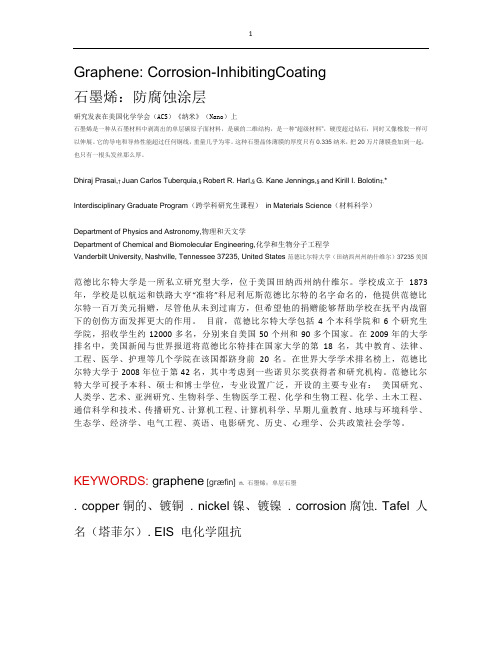
Graphene: Corrosion-InhibitingCoating石墨烯:防腐蚀涂层研究发表在美国化学学会(ACS)《纳米》(Nano)上石墨烯是一种从石墨材料中剥离出的单层碳原子面材料,是碳的二维结构,是一种“超级材料”,硬度超过钻石,同时又像橡胶一样可以伸展。
它的导电和导热性能超过任何铜线,重量几乎为零。
这种石墨晶体薄膜的厚度只有0.335纳米,把20万片薄膜叠加到一起,也只有一根头发丝那么厚。
Dhiraj Prasai,† Juan Carlos Tuberquia,§Robert R. Harl,§G. Kane Jennings,§and Kirill I. Bolotin‡,* Interdisciplinary Graduate Program(跨学科研究生课程)in Materials Science(材料科学)Department of Physics and Astronomy,物理和天文学Department of Chemical and Biomolecular Engineering,化学和生物分子工程学Vanderbilt University, Nashville, Tennessee 37235, United States范德比尔特大学(田纳西州州纳什维尔)37235美国范德比尔特大学是一所私立研究型大学,位于美国田纳西州纳什维尔。
学校成立于1873年,学校是以航运和铁路大亨“准将”科尼利厄斯范德比尔特的名字命名的,他提供范德比尔特一百万美元捐赠,尽管他从未到过南方,但希望他的捐赠能够帮助学校在抚平内战留下的创伤方面发挥更大的作用。
目前,范德比尔特大学包括4个本科学院和6个研究生学院,招收学生约12000多名,分别来自美国50个州和90多个国家。
在2009年的大学排名中,美国新闻与世界报道将范德比尔特排在国家大学的第18名,其中教育、法律、工程、医学、护理等几个学院在该国都跻身前20名。
石墨烯参考资料汇总
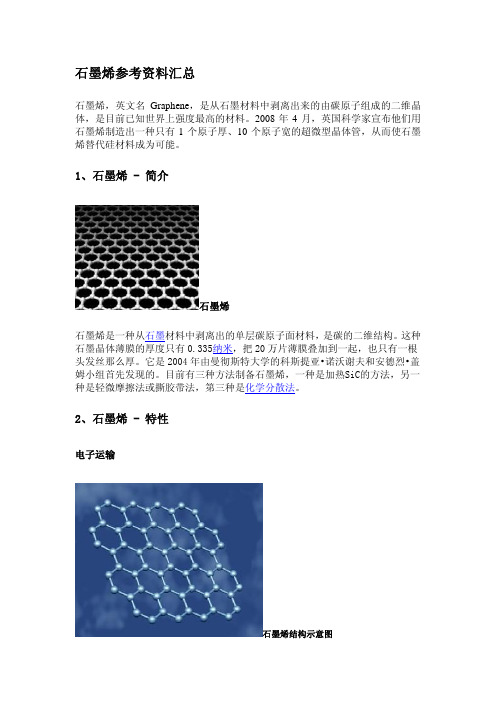
石墨烯参考资料汇总石墨烯,英文名Graphene,是从石墨材料中剥离出来的由碳原子组成的二维晶体,是目前已知世界上强度最高的材料。
2008年4月,英国科学家宣布他们用石墨烯制造出一种只有1个原子厚、10个原子宽的超微型晶体管,从而使石墨烯替代硅材料成为可能。
1、石墨烯 - 简介石墨烯石墨烯是一种从石墨材料中剥离出的单层碳原子面材料,是碳的二维结构。
这种石墨晶体薄膜的厚度只有0.335纳米,把20万片薄膜叠加到一起,也只有一根头发丝那么厚。
它是2004年由曼彻斯特大学的科斯提亚•诺沃谢夫和安德烈•盖姆小组首先发现的。
目前有三种方法制备石墨烯,一种是加热SiC的方法,另一种是轻微摩擦法或撕胶带法,第三种是化学分散法。
2、石墨烯 - 特性电子运输石墨烯结构示意图在发现石墨烯以前,大多数(如果不是所有的话)物理学家认为,热力学涨落不允许任何二维晶体在有限温度下存在。
所以,它的发现立即震撼了凝聚态物理界。
虽然理论和实验界都认为完美的二维结构无法在非绝对零度稳定存在,但是单层石墨烯在实验中被制备出来。
这些可能归结于石墨烯在纳米级别上的微观扭曲。
石墨烯还表现出了异常的整数量子霍尔行为。
其霍尔电导=2e²/h,6e²/h,10e²/h.... 为量子电导的奇数倍,且可以在室温下观测到。
这个行为已被科学家解释为“电子在石墨烯里遵守相对论量子力学,没有静质量”。
导电性石墨烯结构非常稳定,迄今为止,研究者仍未发现石墨烯中有碳原子缺失的情况。
石墨烯中各碳原子之间的连接非常柔韧,当施加外部机械力时,碳原子面就弯曲变形,从而使碳原子不必重新排列来适应外力,也就保持了结构稳定。
这种稳定的晶格结构使碳原子具有优异的导电性。
石墨烯中的电子在轨道中移动时,不会因晶格缺陷或引入外来原子而发生散射。
由于原子间作用力十分强,在常温下,即使周围碳原子发生挤撞,石墨烯中电子受到的干扰也非常小。
石墨烯最大的特性是其中电子的运动速度达到了光速的1/300,远远超过了电子在一般导体中的运动速度。
石墨烯——外国语学院英 语翻译专业2011级杨晗(改变世界的物理学选修).ppt )
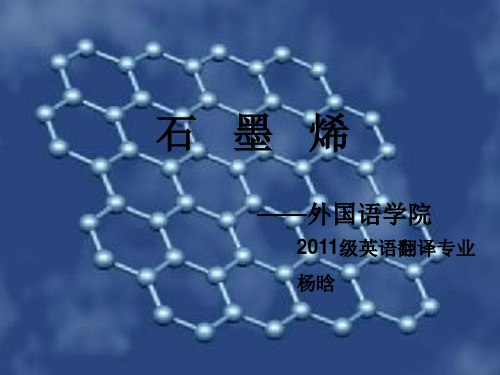
石墨烯的发现故事
(这是两年前Geim在他办公室接受Science Watch采访 时讲的,Geim叙述了发现石墨烯的有趣故事)
Geim 说他的实验室里刚来了一位来自中国的博士生。我买 了一块高定向裂解石墨(HOPG),请这位博士生制成薄膜,要求尽可 能地薄。起初我给他一台精巧的抛光机让他研磨。三周后他来见我, 他说成功了。他给我看一个培养皿,在培养皿底部有一些石墨的小 斑点。我用显微镜观察,估计这些石墨碎片仍然有10微米厚,大 概 1000层左右。我问他:“你能否再研磨得薄一点?”这位博士 生说:“我需要另一快HOPG” 一块HOPG的售 价当时约300美元。Geim说“我当时向他解释时一定是不太礼貌, 我说你不必磨掉整块砖头才指望获得一粒沙子吧。不料他同样有礼 貌地回答道:“如果你这么聪明,你自己试试。”这就是一个转折 点,面对学生的叫板,Geim自己来试,决定用透明胶带。
石墨烯另一个特性,是能够在常温下观察到量子霍尔效应。 石墨烯的碳原子排列与石墨的单原子层雷同,是碳原子以sp2 混成轨域呈蜂巢晶格(honeycomb crystal lattice)排列构成的单层 二维晶体。石墨烯可想像为由碳原子和其共价键所形成的原子尺寸 网。石墨烯的命名来自英文的graphite(石墨) + -ene(烯类结尾)。石 墨烯被认为是平面多环芳香烃原子晶体。 石墨烯的结构非常稳定,碳碳键(carbon-carbon bond)仅为 1.42Å。石墨烯内部的碳原子之间的连接很柔韧,当施加外力 于石墨烯时,碳原子面会弯曲变形,使得碳原子不必重新排列来适 应外力,从而保持结构稳定。这种稳定的晶格结构使石墨烯具有优 秀的导热性。另外,石墨烯中的电子在轨道中移动时,不会因晶格 缺陷或引入外来原子而发生散射。由于原子间作用力十分强,在常 温下,即使周围碳原子发生挤撞,石墨烯内部电子受到的干扰也非 常小。石墨烯是构成下列碳同素异形体的基本单元:石墨,木炭, 碳纳米管七边形存在,则会构成石墨烯的缺陷。12个 五角形石墨烯会共同形成富勒烯。 石墨烯是一种二维晶体,最大的特性是其中电子的运动速度达到 了光速的1/300,远远超过了电子在一般导体中的运动速度。这使得 石墨烯中的电子,或更准确地,应称为“载荷子”(electric charge carrier),的性质和相对论性的中微子非常相似。
材料科学专业毕业设计外文文献及翻译

材料科学专业毕业设计外文文献及翻译文献摘要为了适应不断发展的材料科学领域,毕业设计需要参考一些权威的外文文献。
在这里,我们提供了一些与材料科学专业相关的外文文献,并附带简要翻译。
---文献1: "石墨烯在材料科学中的应用"作者: John Smith, Mary Johnson: John Smith, Mary Johnson摘要::本文综述了石墨烯在材料科学中的应用。
石墨烯是一种单层碳原子结构,具有独特的物理和化学性质。
我们讨论了石墨烯的制备方法、其在电子学、能源存储和生物医学领域中的应用。
石墨烯在材料科学中具有巨大的潜力,可以为未来的材料研究和应用开辟新的道路。
---文献2: "纳米材料的合成与性能研究"作者: David Brown, Emma Lee: David Brown, Emma Lee摘要::本文讨论了纳米材料的合成方法及其性能研究。
纳米材料是具有纳米尺度结构的材料,具有与宏观材料不同的性质。
我们介绍了几种常见的纳米材料合成方法,例如溶液法和气相法,并讨论了纳米材料的晶体结构、表面性质和力学性能。
研究纳米材料的性能对材料科学的发展和应用具有重要意义。
---文献3: "高温合金的热稳定性研究"作者: Jennifer Zhang, Michael Wang: Jennifer Zhang, Michael Wang摘要::本文研究了高温合金的热稳定性。
高温合金是一种用于高温环境的特殊材料,具有优异的耐热性能。
我们通过实验研究了高温合金的热膨胀性、热导率和高温力学性能。
通过了解高温合金的热稳定性,我们可以提高材料的耐高温性能,从而推动高温环境下的应用和工程技术发展。
---以上是几篇关于材料科学的外文文献摘要及简要翻译,希望对毕业设计的参考有所助益。
文献阅读-石墨烯
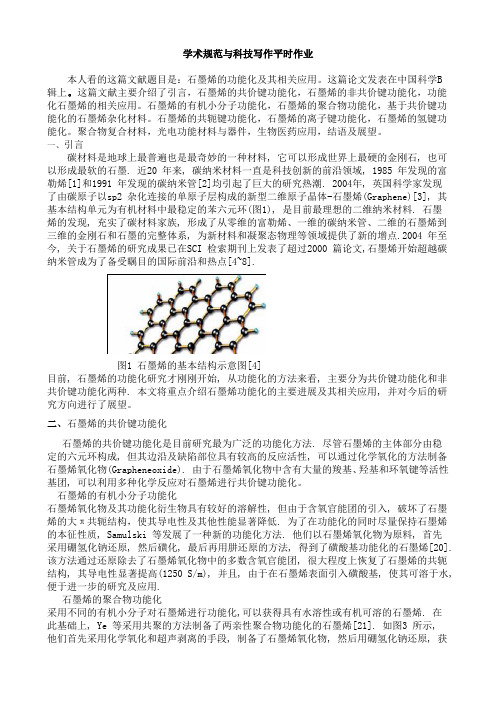
学术规范与科技写作平时作业本人看的这篇文献题目是:石墨烯的功能化及其相关应用。
这篇论文发表在中国科学B辑上。
这篇文献主要介绍了引言,石墨烯的共价键功能化,石墨烯的非共价键功能化,功能化石墨烯的相关应用。
石墨烯的有机小分子功能化,石墨烯的聚合物功能化,基于共价键功能化的石墨烯杂化材料。
石墨烯的共轭键功能化,石墨烯的离子键功能化,石墨烯的氢键功能化。
聚合物复合材料,光电功能材料与器件,生物医药应用,结语及展望。
一、引言碳材料是地球上最普遍也是最奇妙的一种材料, 它可以形成世界上最硬的金刚石, 也可以形成最软的石墨. 近20 年来, 碳纳米材料一直是科技创新的前沿领域, 1985 年发现的富勒烯[1]和1991 年发现的碳纳米管[2]均引起了巨大的研究热潮. 2004年, 英国科学家发现了由碳原子以sp2 杂化连接的单原子层构成的新型二维原子晶体-石墨烯(Graphene)[3], 其基本结构单元为有机材料中最稳定的苯六元环(图1), 是目前最理想的二维纳米材料. 石墨烯的发现, 充实了碳材料家族, 形成了从零维的富勒烯、一维的碳纳米管、二维的石墨烯到三维的金刚石和石墨的完整体系, 为新材料和凝聚态物理等领域提供了新的增点.2004 年至今, 关于石墨烯的研究成果已在SCI 检索期刊上发表了超过2000 篇论文,石墨烯开始超越碳纳米管成为了备受瞩目的国际前沿和热点[4~8].图1 石墨烯的基本结构示意图[4]目前, 石墨烯的功能化研究才刚刚开始, 从功能化的方法来看, 主要分为共价键功能化和非共价键功能化两种. 本文将重点介绍石墨烯功能化的主要进展及其相关应用, 并对今后的研究方向进行了展望。
二、石墨烯的共价键功能化石墨烯的共价键功能化是目前研究最为广泛的功能化方法. 尽管石墨烯的主体部分由稳定的六元环构成, 但其边沿及缺陷部位具有较高的反应活性, 可以通过化学氧化的方法制备石墨烯氧化物(Grapheneoxide). 由于石墨烯氧化物中含有大量的羧基、羟基和环氧键等活性基团, 可以利用多种化学反应对石墨烯进行共价键功能化。
石墨烯 英文综述 论文
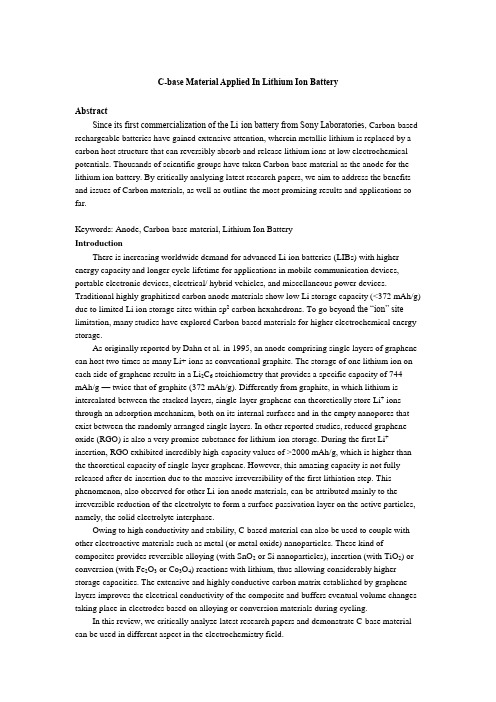
C-base Material Applied In Lithium Ion BatteryAbstractSince its first commercialization of the Li-ion battery from Sony Laboratories, Carbon-based rechargeable batteries have gained extensive attention, wherein metallic lithium is replaced by a carbon host structure that can reversibly absorb and release lithium ions at low electrochemical potentials. Thousands of scientific groups have taken Carbon-base material as the anode for the lithium ion battery. By critically analysing latest research papers, we aim to address the benefits and issues of Carbon materials, as well as outline the most promising results and applications so far.Keywords: Anode, Carbon-base material, Lithium Ion BatteryIntroductionThere is increasing worldwide demand for advanced Li ion batteries (LIBs) with higher energy capacity and longer cycle lifetime for applications in mobile communication devices, portable electronic devices, electrical/ hybrid vehicles, and miscellaneous power devices. Traditional highly graphitized carbon anode materials show low Li storage capacity (<372 mAh/g) due to limited Li ion storage sites within sp2 carbon hexahedrons. To go beyon d the “ion” site limitation, many studies have explored Carbon-based materials for higher electrochemical energy storage.As originally reported by Dahn et al. in 1995, an anode comprising single layers of graphene can host two times as many Li+ ions as conventional graphite. The storage of one lithium ion on each side of graphene results in a Li2C6 stoichiometry that provides a specific capacity of 744 mAh/g — twice that of graphite (372 mAh/g). Differently from graphite, in which lithium is intercalated between the stacked layers, single-layer graphene can theoretically store Li+ ions through an adsorption mechanism, both on its internal surfaces and in the empty nanopores that exist between the randomly arranged single layers. In other reported studies, reduced graphene oxide (RGO) is also a very promise substance for lithium-ion storage. During the first Li+ insertion, RGO exhibited incredibly high-capacity values of >2000 mAh/g, which is higher than the theoretical capacity of single-layer graphene. However, this amazing capacity is not fully released after de-insertion due to the massive irreversibility of the first lithiation step. This phenomenon, also observed for other Li-ion anode materials, can be attributed mainly to the irreversible reduction of the electrolyte to form a surface passivation layer on the active particles, namely, the solid electrolyte interphase.Owing to high conductivity and stability, C-based material can also be used to couple with other electroactive materials such as metal (or metal oxide) nanoparticles. These kind of composites provides reversible alloying (with SnO2 or Si nanoparticles), insertion (with TiO2) or conversion (with Fe2O3 or Co3O4) reactions with lithium, thus allowing considerably higher storage capacities. The extensive and highly conductive carbon matrix established by graphene layers improves the electrical conductivity of the composite and buffers eventual volume changes taking place in electrodes based on alloying or conversion materials during cycling.In this review, we critically analyze latest research papers and demonstrate C-base material can be used in different aspect in the electrochemistry field.Graphene as an active materialIn lithium-ion batteries (LIBs), Li+ ions continuously shuttle between a lithium-releasing cathode (commonly a layered lithium metal oxide) and a lithium-accepting anode (commonly graphite). The amount of ions hosted per gram of material determines the capacity — and thus the energy — of the battery. Similar to graphite, graphene can be used as an anode for hosting Li+, both as such and as a carbonaceous matrix in composites with other materials also capable of storing lithium.Graphene-prepared by different methodsGraphene nanosheets have significant disorder/defects, large specific surface area, and remaining surface functional groups. All these factors have ever been proposed to be related to additional Li storage capacity in nongraphite carbonaceous materials with high specific capacities. Dengyu Pan et al synthesize a highly disordered graphene nanosheet with an outstanding capacity of 794-1054 mAh/g. They prepare graphene nanosheets with different disorder level by changing reduction methods and conditions. A series of graphene nanosheet samples were prepared from graphene oxide (GO) sheets via three different routes including hydrazine reduction, pyrolytic deoxidation and electron beam irradiation.Figure 1 Raman spectra of four different reductionsRaman spectra with characteristic G and D bands sensitive to defects, disorder, and carbon grain size have extensively been used to characterize carbon materials. The G band arises from the zone center E2g mode, corresponding to ordered sp2 bonded carbon, whereas the D band is ascribed to edges, other defects, and disordered carbon. The I D/I G intensity ratio is a measure of disorder degree and average size of the sp2 domains. Figure 1 displays the Raman spectra of four different reduction samples. Figure 1b shows Electron Beam reduced GO has a I D/I G of 1.51 and Hydrazine Reduced GO has a smaller I D/I G of 0.74. Figure 1c displays the Raman spectra of the pristine and pyrolytic GO. For the 300℃pyrolytic GO, however, the G band disappears. The disappearance of the G band arises from the destruction of the E2g symmetry and structural distortion of sp2 domains induced by the low-temperature pyrolysis.Figure 2 shows reversible capability verse cycle Figure 2 Cycle performance number of above materials. (i) natural graphite (ii)pristine GO (iii) hydrazine-reduced GO (iv) 300℃pyrolytic GO (v) 600 ℃pyrolytic GO (vi) andelectron-beam-reduced GO. It can be easily to drawthe conclusion that the material with higher I D/I Gdisplays a better electrochemistry performance.They can correlate the reversible capacity with theRaman intensity ratio. That is, Raman intensityratio (I D/I G) may be the key structural parameter for evaluation of the reversible capacity. What is more, they propose a mechanism to explain how Raman intensity ratio is correlated with the reversible capacity. The I D/I G ratio describes disorder degree in carbonaceous materials because the D band is ascribed to disordered carbon, edge defects, and other defects.Scheme 1 The Li storage model of graphene nanosheetsThe Li storage model of graphene nanosheets is suggested in Scheme 1. The defects at the interface between the nanosheets and the electrolyte may accommodate irreversible Li present in SEI films, whereas the defects at edge sites and internal (basal-plane) defects (vacancies etc.) of the nanodomains embedded in graphene nanosheets may involve reversible Li storage because these defects do not come into contact with the electrolyte. Some Li ions may be stored reversibly between (002) planes, but the defect-based reversible storage may predominate. The notable capacity fading observed in the highly disordered samples may be ascribed to the disorder-induced structure instability.Graphene-doped by other elementsAnother method to improve defects and vacancies is to dope other elements to graphene. It is generally believe that lithium ion batteries (LIBs) using a bulk material such as layered graphite or metal oxide as an anode are capable of achieving a high energy density by storing charges in the bulk of the material, but suffer from a low power density compared to another important electrochemical storage device, electrochemical capacitors (ECs).In order to meet the requirements for LIB applications, Zhong-Shuai Wu et al synthesize the doped graphene electrodes with extremely high rate and large capacity made by heteroatom (N, B)- doped chemically derived graphene. At a low charge/discharge rate of 50 mA /g, the doped graphene electrodes exhibit a very high capacity of 1043 mAh/g for N-doped graphene and 1549 mAh/g for B-doped graphene with greatly improved Coulombic efficiency and cycle performance in comparison with undoped graphene. More importantly, the doped graphene can be quickly charged and discharged for a very short time of 1 h to several tens of seconds, showing high rate capability and excellent long-term cyclability at the same time.At a very high current rate of 25A /g (seen in Figure 3), corresponding to a charge time of28s (126C) for the N-doped graphene and 33s (106 C) for the B-doped graphene, the reversible capacity can still reach 199 mAh/g for the N-doped graphene and 235 mAh/g for the B-doped graphene.Figure 3 The rate performance of N-doped (c) and B-doped (d) graphene What’s more, these doped graphene sheets show a higher thermal stability of 531℃for the N-doped graphene and 588℃for the B-doped graphene than that of pristine graphene (502℃) due to the simultaneous doping and reduction during the doping process. The author suppose that improved electrical conductivity, and thermal stability of the doped graphene allow rapid surface Lit absorption and ultrafast Li+ diffusion and electron transport, thus making this material superior to conventional bulk electrode materials based on Li intercalation and conversion reactions. Graphene as an inactive materialLiCoO2, LiMn2O4 and LiFePO4 (hereafter referred to as LMO) are some of the most commonly used cathode materials in LIBs. The cycle life and rate capability of these materials are generally limited by their poor electrical conductivity. Introducing low-cost conductive additives (for example, carbon black) into the composite electrodes commonly solves this issue. Nevertheless, owing to their amorphous structure, carbon blacks possess a rather low electrical conductivity, with respect to more crystalline carbons such as graphene.Thousands of papers related to graphene are applied in LIB system, we demonstrate an interesting strategy that Shubin et al Yang synthesize a sandwich-like graphene-base titaniananosheets (seen scheme 2).Scheme 2 Illustration of sandwich compositeTo circumvent the drawbacks of titania, graphene with high electrical conductivity have beenutilized as matrices or conductive additives to improve its electrochemical performance. Thegraphene in the composite serve as a mini current collector, which can improve electronconductivity and leads to an dramatic improvement of electrochemical performance. As shown inthe Figure 4, it is striking that a high first discharge capacity of 269 mAh/g is achieved at a currentrate of 0.2 C (Figure 4), corresponding to a lithium insertion coefficient of 0.8 in Li0.8TiO2 . Thisvalue is much higher than the theoretical capacity of titania (167.5 mAh/g ) with the maximumcoefficient of 0.5 (Li0.5TiO2), suggesting the existence of additional lithium storage sites in ourG-TiO2 nanosheets.Figure 4 The cyclability of sandwich composite&TiO2ConclusionCarbon-base material, which can not only be served as an anode but also be used as an inactive material, plays an important role in lithium ion battery system. It arises from graphite, but it’s better than graphite for its breaking down the theoretical limitation of capacity( 372mAh/g ).This is particularly appropriate for the field of electrochemical energy storage, in which ‘graphene fever’ has reached rather high levels due to the continuous need for new materials that can meet the market’s performance requirements. We believe that Carbon-base material, especially graphene, will dominate the market of anode for a long time.Reference[1] Dengyu Pan et.a l. Li Storage Properties of Disordered Graphene Nanosheets. Chem. Mater. 2009, 21, 3136–3142[2] Zhong-Shuai Wu et.a l. Doped Graphene Sheets As Anode Materials with Superhigh Rate and Large Capacity for Lithium Ion Batteries. ACS Nano. 2011, Vol 5,No 7, 5463–5471[3]Shubin Yang et.al. Sandwich-Like, Graphene-Based Titania Nanosheets with High Surface Area for Fast Lithium Storage. Adv. Mate r. 2011, 23, 3575–3579[4] Arava Leela Mohana Reddy et.al. Synthesis Of Nitrogen-Doped Graphene Films For Lithium Battery Application. ACS Nano. 2010, Vol 4,No 11, 6337–6342[5] EunJoo Yoo et al. Large Reversible Li Storage of Graphene Nanosheet Families for Use in Rechargeable Lithium Ion Batteries. ACS2008 Vol.8 NO.8 2277-2282。
石墨烯的研究进展及应用的翻译讲稿
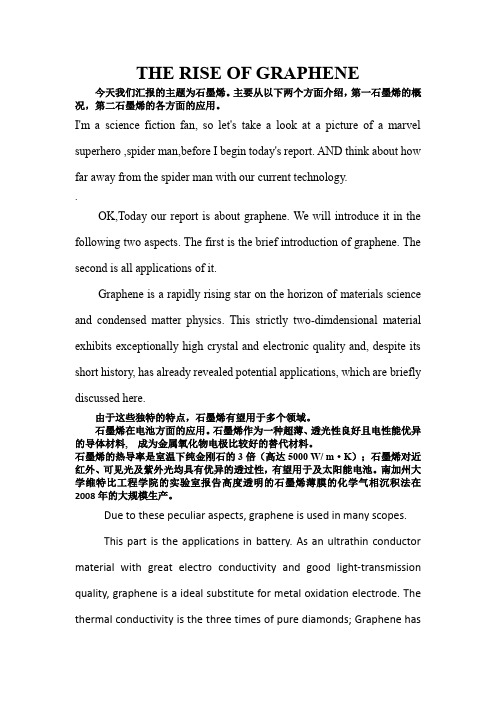
THE RISE OF GRAPHENE 今天我们汇报的主题为石墨烯。
主要从以下两个方面介绍,第一石墨烯的概况,第二石墨烯的各方面的应用。
I'm a science fiction fan, so let's take a look at a picture of a marvel superhero ,spider man,before I begin today's report. AND think about how far away from the spider man with our current technology..OK,Today our report is about graphene. We will introduce it in the following two aspects. The first is the brief introduction of graphene. The second is all applications of it.Graphene is a rapidly rising star on the horizon of materials science and condensed matter physics. Thisstrictly two-dimdensional material exhibits exceptionally high crystal and electronic quality and, despite itsshort history, has already revealed potential applications, which arebriefly discussed here.由于这些独特的特点,石墨烯有望用于多个领域。
石墨烯在电池方面的应用。
石墨烯作为一种超薄、透光性良好且电性能优异的导体材料, 成为金属氧化物电极比较好的替代材料。
英文文献翻译

英⽂⽂献翻译天然⽯墨烯作为锂离⼦电池负极材料的先进表⾯和显微结构特点为了改进天然⽯墨作为锂离⼦电池负极材料在长时间循环中不可逆容量损失和容量滞留,天然⽯墨要经受⼀系列的热处理。
在惰性氮⽓和氩⽓中进⾏基线热处理被⽐作添加炉内⽓体,这种添加实际上改变了未包覆⽯墨粉的化学表⾯,导致显著提⾼锂离⼦电池长时间的循环性能在商业上、碳包覆⽯墨⽅⾯。
在950~2900摄⽒度不同的热处理温度表明会满⾜不同要求在长时间循环过程中,并且减少热预算。
⼀个详细的特征数据被呈现包括X射线衍射、X射线光电⼦能谱、拉曼光谱、温度升温吸附质谱。
在锂离⼦的全电池中特性数据和可以观察到是容量衰减提⾼⼤电流放电的长时间循环。
有⼈认为长期性能提⾼是形成更稳定的固体电解质界⾯膜在负极⽯墨表⾯所形成的,这些是和表⾯化学修饰直接相关的,被专有⽓体环境在热处理过程中。
2.钒酸锂/⽯墨复合材料作为锂离⼦电池负极材料的电化学性能研究研究表明,⽤⽯墨烯精梳Li3VO4和⽤碳包覆Li3VO4能有效提⾼它的电化学性能,Li3VO4/C复合材料作为锂离⼦电池负极材料具有很⼤的电势。
然⽽,从⾼成本、复杂的合成⽅法、聚合的难易程度等⽅⾯来考虑,⽯墨烯相⽐于其他碳材料有很多缺点,因此不适合⼤规模⽣产。
与⽯墨烯相反,天然⽯墨在⾃然界中很丰富,相⽐于其他碳材料有很⼤优势,⽐如:低成本、电⼦导电率⾼并且结构稳定性好,这些特点使得天然⽯墨成为⼀种优良的复合电极材料。
在这篇⽂章中,我们⽤⼀种温和的⽅法将Li3VO4纳⽶粒⼦沉积在天然⽯墨上,⽤这种⽅法合成的⽯墨作为锂离⼦电池负极材料具有优良的电化学性能。
设备简单、成本低、预备反应效率⾼等特点有利于⼤规模合成Li3VO4/天然复合材料及在锂离⼦电池中的实际应⽤。
实验:制作⼯序分析级化学试剂(上海化学试剂⼚)天然⽯墨(宜昌恒⼤⽯墨公司99.9%)在⼀个典型程序中1 mmol V2O5, 3 mmol Li2CO3 and 5 mmol 环六亚甲基四胺(乌洛托品)溶解于30ml蒸馏⽔中。
石墨烯文献

1、Free-Sta nding Hierarchically San dwich-Type Tun gste n Disulfide Nano tubes/Graphe neAnode for Lithium-Io n Batteries (独立的分层三明治型WS2纳米管与石墨烯复合型锂离子电池阳极材料)Renjie Chen, Teng Zhao, Weiping Wu, Feng Wu, Li Li, Ji Qian, Rui Xu,Huiming Wu, Hassan M. Albishri, A.S. Al-Bogami, Deia Abd El-Hady, Jun Lu, and Khalil AmineNano Lett., 2014, 14 (10), pp 5899 -5904Publication Date (Web): August 27, 2014 (Letter)DOI: 10.1021/nl502848z2、Graphene Nanoribbon/V z O s Cathodes in Lithium-IonBatteries (石墨烯纳米带与V2O5复合锂离子电池阴极)Yang Yang, Lei Li, Huilong Fei, Zhiwei Peng, Gedeng Ruan, and James M.TourACS Appl. Mater. Interfaces, 2014, 6 (12), pp 9590 -9594Publication Date (Web): May 20, 2014 (Research Article)DOI: 10.1021/am501969m3、Ano malous In terfacial Lithium Storage in Graphe ne/TiO2for Lithium Ion Batteries (锂离子电池用石墨烯/TiO2复合材料的无定形界面中Li存储研究)Enzuo Liu, Jiamei Wang, Chunsheng Shi, Naiqin Zhao, Chunnian He, JiajunLi, and Jian-Zhong JiangACS Appl. Mater. Interfaces, 2014, 6 (20), pp 18147 -8151Publication Date (Web): September 23, 2014 (Research Article)DOI: 10.1021/am50504234、Carbon-Coated Mesoporous TQ2 Nano crystals Grow n on Graphe ne forLithium-Ion Batteries (在石墨烯上生长用于锂离子电池的碳包覆介孔TiO2纳米晶)Zehui Zhang, Ludan Zhang, Wei Li, Aishui Yu, and Peiyi WuACS Appl. Mater. Interfaces, 2015, 7 (19), pp 10395 -0400Publication Date (Web): April 30, 2015 (Research Article)DOI: 10.1021/acsami.5b014505、Tin Disulfide Nano plates on Graphe ne Nan oribb ons for Full Lithium Ion Batteries (在石墨烯纳米带上生长用于全锂离子电池的SnS2纳米盘)Caitian Gao, Lei Li, Abdul-Rahman O. Raji, Anton Kovalchuk, Zhiwei Peng,Huilong Fei, Yongmin He, NamDong Kim, Qifeng Zhong, Erqing Xie, andJames M. TourACS Appl. Mater. Interfaces, 2015, 7 (48), pp 26549 -26556Publication Date (Web): November 12, 2015 (Research Article)DOI: 10.1021/acsami.5b077686、Si ~Mn/Reduced Graphe ne Oxide Nano composite Ano des with Enhanced Capacity and Stability for Lithium-Io nBatteries (用于提高锂离子电池的容量和稳定性的Si-Mn/还原氧化石墨烯纳米复合阴极材料)A Reum Park, Jung Sub Kim, Kwang Su Kim, Kan Zhang, Juhyun Park, Jong Hyeok Park, Joong Kee Lee, and PilJ. YooACS Appl. Mater. Interfaces, 2014, 6 (3), pp 1702 -1708Publication Date (Web): January 20, 2014 (Research Article)DOI: 10.1021/am404608d7、Branched Graphene Nanocapsules for Anode Material ofl.ithium-lon Batteries (用于锂离子电池阴极材料的树枝状石墨烯纳米胶囊材料)Chuangang Hu, Lingxiao Lv, Jiangli Xue, Minghui Ye, Lixia Wang, andLiangti QuChem. Mater., 2015, 27 (15), pp 5253 -5260Publication Date (Web): July 14, 2015 (Article)DOI: 10.1021/acs.chemmater.5b01398& Three-Dimensional Macroporous Graphene -_i2FeSiO4Composite as Cathode Material for Lithium-lo n Batterieswith Superior Electrochemical Performa nces (用于锂离子电池、具有优异的电化学性能的三维多孔石墨烯-Li 2FeSiO4复合阳极材料)Hai Zhu, Xiaozhen Wu, Ling Zan, and Youxiang ZhangACS Appl. Mater. Interfaces, 2014, 6 (14), pp 11724 -1733Publication Date (Web): June 25, 2014 (Research Article)DOI: 10.1021/am502408m9、Fluorine-Doped SnO?@Graphene Porous Composite for HighCapacity Lithium-Ion Batteries (用于高容量锂离子电池的氟掺杂SnO2@石墨烯多孔复合材料)Jinhua Sun, Linhong Xiao, Shidong Jiang, Guoxing Li, Yong Huang, andJianxin GengChem. Mater., 2015, 27 (13), pp 4594 -4603Publication Date (Web): June 16, 2015 (Article)DOI: 10.1021/acs.chemmater.5b0088510、H ighly Conductive Freestanding Graphene Films as Anode Current Collectors for Flexible Lithium-lonBatteries (用于柔性锂离子电池集流体的具有高电导率独立石墨烯薄膜)Kuldeep Rana, Jyoti Singh, Jeong-Taik Lee, Jong Hyeok Park, and Jong-Hyun AhnACS Appl. Mater. Interfaces, 2014, 6 (14), pp 11158 -1166Publication Date (Web): April 23, 2014 (Research Article)DOI: 10.1021/am500996c11、G raphe ne as an In terfacial Layer for Improv ing Cycli ng Performa nee of Si Nano wiresin Lithium-Ion Batteries (石墨烯作为界面层提高锂离子电池用Si纳米线的循环性能)Fan Xia, Sunsang Kwon, Won Woo Lee, Zhiming Liu, Suhan Kim, TaeseupSong, Kyoung Jin Choi, Ungyu Paik, and Won Il ParkNano Lett., 2015, 15 (10), pp 6658 七664Publication Date (Web): September 11,2015 (Letter)DOI: 10.1021/acs.nanolett.5b0248212、F abrication of Graphene Embedded LiFePO4 Using a Catalyst Assisted Self AssemblyMethod as a Cathode Material for High Power Lithium-lo n Batteries (用催化辅助自组装法制备用于高能量型锂离子电池的嵌有石墨烯的LiFePO4的阳极材料)WonKeun Kim, WonHee Ryu, DongWook Han, SungJin Lim, JiYong Eom, and HyukSang KwonACS Appl. Mater. Interfaces, 2014, 6 (7), pp 4731 -4736Publication Date (Web): March 12, 2014 (Research Article)DOI: 10.1021/am405335k13、M esoporous Td Nanocrystals Grown in Situ onGraphene Aerogels for High Photocatalysis and Lithium-lon Batteries (在石墨烯上原位生长微孔TiO2纳米晶以用于高效光催化和锂离子电池)Bocheng Qiu, Mingyang Xing, and Jinlong ZhangJ. Am. Chem. Soc., 2014, 136 (16), pp 5852 -855Publication Date (Web): April 8, 2014 (Communication)DOI: 10.1021/ja500873u14、F abrication of Nitrogen-Doped Holey Graphene Hollow Microspheres and Their Use as an Active Electrode Material for Lithium Ion Batteries (在中空微米球上制备氮掺杂多孑L石墨烯机器用于锂离子电池的活性电极中)Zhong-Jie Jiang and Zhongqing JiangACS Appl. Mater. Interfaces, 2014, 6 (21), pp 19082 -9091Publication Date (Web): October 13, 2014 (Research Article)DOI: 10.1021/am505060415、E lastic a-Silic on Nano particle Backb oned Graphe neHybrid as a Self-Compact ing Anode for High-Rate Lithiumlon Batteries (用于高倍率锂离子电池的具有自密实的阴极材料:生长弹性a-Si纳米颗粒的石墨烯)Minseong Ko, Sujong Chae, Sookyung Jeong, Pilgun Oh, and Jaephil ChoACS Nano, 2014, 8 (8), pp 8591 七599Publication Date (Web): July 31,2014 (Article)DOI: 10.1021/nn503294z16、H igh-Rate, Ultralong Cycle-Life Lithium/Sulfur BatteriesEnabled byNitrogen-Doped Graphene (用于高倍率超长循环寿命Li-S电池的氮掺杂石墨烯)Yongcai Qiu, Wanfei Li, Wen Zhao, Guizhu Li, Yuan Hou, Meinan Liu, LishaZhou, Fangmin Ye, Hongfei Li, Zha nhua Wei, Shihe Yang, Wenhui Duan,Yifan Ye, Jinghua Guo, and Yuegang ZhangNano Lett., 2014, 14 (8), pp 4821 -4827Publication Date (Web): July 29, 2014 (Letter)DOI: 10.1021/nl502047518、P hosphorus and Nitrogen Dual-Doped Few-Layered Porous Graphene: AHigh-Performa nee Anode Material for Lithium-I on Batteries (一种用于锂离子电池的具有高性能阴极材料:磷和氮双共掺杂少层多孔石墨烯)Xinlong Ma, Guoqing Ning, Chuanlei Qi, Chenggen Xu, and Jinsen GaoACS Appl. Mater. Interfaces, 2014, 6 (16), pp 14415 -4422Publication Date (Web): August 8, 2014 (Research Article)DOI: 10.1021/am503692g19、A n Advaneed Lithium-Ion Battery Based on a GrapheneAnode and a Lithium Iron Phosphate Cathode (一种基于石墨烯阴极和LiFePO4阳极的先进锂离子电池)Jusef Hassoun, Francesco Bonaccorso, Marco Agostini, Marco Angelucci,MariaGrazia Betti, Roberto Cingolani, Mauro Gemmi, Carlo Mariani,Stefania Panero, Vittorio Pellegrini, and Bruno Scrosati Nano Lett., 2014, 14 (8), pp 4901 -4906Publication Date (Web): July 15, 2014 (Letter)DOI: 10.1021/nl502429m20、U ltrasmall TiO 2 Nanoparticles in Situ Growth onGraphene Hybrid as Superior AnodeACS Appl. Mater. Interfaces, 2015, 7 (21), pp 11239 -1245Publication Date (Web): May 12, 2015 (Research Article)DOI: 10.1021/acsami.5b02724Material for Sodium/Lithium Ion Batteries (石墨烯上原位生长超小TiO2纳米颗粒复合材料用作钠/锂离子电池阴极材料)Huiqiao Liu, Kangzhe Cao, Xiaohong Xu, Lifang Jiao, Yijing Wang, andHuatang Yuan21、General Strategy for Fabricating Sandwich-likeGraphene-Based Hybrid Films for Highly ReversibleLithium Storage (用于高可逆Li存储的类三明治石墨烯基混合薄膜的常用制备方法)Xiongwu Zhong, Zhenzhong Yang, Xiaowu Liu, Jiaqing Wang, Lin Gu, andYan YuACS Appl. Mater. Interfaces, 2015, 7 (33), pp 18320 -8326Publication Date (Web): August 10, 2015 (Research Article)DOI: 10.1021/acsami.5b0394222、An ionic self-assembly approach towards sandwich-like graphene/SnOgraphene nano sheets for enhan ced lithium storage一种离子自组装法制备用于提高Li存储的类三明治型纳米片:石墨烯/SnO2/石墨烯)Jin zua n Wang, Ping Liu, Yan sha n Huang, Jia nzhong Jia ng, Sheng Han, Dongqing Wu andXin lia ng FengRSC Adv., 2014,4, 57869-57874DOI: 10.1039/C4RA10573G, Paper23、3D porous hybrids of defect-rich MoS2/graphe ne nano sheets with excelle nt electrochemical performa nee as anode materials for lithium ion batteries锂离子电池用具有优异的电化学性能的三维多孔复合阴极材料:具有大量缺陷的MoS2/石墨烯纳米片)Lon gshe ng Zhang, Wei Fan, Weng Weei Tjiu and Tianxi LiuRSC Adv., 2015,5, 34777-34787DOI: 10.1039/C5RA04391C, Paper24、Nb2O5/graphe ne nano composites for electrochemical en ergy storag 用于电化学能量存储的Nb2O5/石墨烯纳米复合材料)Paulraj Arun kumar, Ajithan G. Ashish, Bi nson Babu, Som Sara ng, Abhi n Suresh, Chithra H. Sharma, Madhu Thalakulam and Manikoth M. ShaijumonRSC Adv., 2015,5, 59997-60004DOI: 10.1039/C5RA07895D, Paper25、Green synthesis of 3D SnO2/graphene aerogels and their application in lithium-ion batteries (绿色合成3DSnO2/石墨烯气凝胶机器在锂离子电池中的应用)Chen Gong, Yon gqua n Zhang, Min ggua ng Yao, Yin gji n Wei, Quanjun Li, Bo Liu, Ran Liu, Zhen Yao, Tia n Cui, Bo Zou and Bingbing LiuRSC Adv., 2015,5, 39746-39751DOI: 10.1039/C5RA05711F, Paper26、Electrochemical lithium storage of a ZnF e2O4/graphe ne nano composite as an anode material for rechargeable lithium ion batterie (可充电锂离子电池阴极材料ZnFe2O4/ 石墨烯纳米复合材料的电化学Li存储)Alok Kumar Rai, Sungjin Kim, Jihyeon Gim, Muhammad Hilmy Alfaruqi, Vinod Mathew andJaekook KimRSC Adv., 2014,4, 47087-47095DOI: 10.1039/C4RA08414D, Paper27、TiO2 nano tubes grow n on graphe ne sheets as adva need anode materials for high rate lithium ion batteries (用于高倍率锂离子电池的在石墨烯片上生长TiO2纳米管的阴极材料)Yufeng Tang, Zhanqiang Liu, Xujie L , Baofe ngWa ng and Fuqia ng HuangRSC Adv., 2014,4, 36372-36376DOI: 10.1039/C4RA05027D, Paper28、N-doped TiO 2 nano tubes/N-doped graphe ne nano sheets composites as high performa nee anode materials in lithium-ion battery (氮掺杂TiO2纳米管/氮掺杂石墨烯纳米片复合材料用于高性能锂离子电池阴极材料)Yuem ing Li, Zhigua ng Wang and Xiao-Jun LvJ. Mater. Chem. A , 2014,2, 15473-15479DOI: 10.1039/C4TA02890B, Paper29、A highly nitrogen-doped porous graphene —an anode material for lithium ion batteries (高氮掺杂多孔石墨烯一一种用于锂离子电池的阴极材料)Zhu-Yin Sui, Caiy un Wang, Qua n-She ng Ya ng, Kewei Shu, Yu-Wen Liu, Bao-Ha ng Han and Gordo n G. WallaceJ. Mater. Chem. A , 2015,3, 18229-18237DOI: 10.1039/C5TA05759K, Paper30、The effect of titanium in Li 3V2(PO4)3/graphene composites as cathode material for high capacity Li-ion batteries (一种用于高容量锂离子电池阳极材料:Ti在Li3V2(PO4)3/石墨烯复合物中的作用)Man soo Choi, Kisuk Kang, Hyun-Soo Kim, Young Moo Lee and Bon g-Soo JinRSC Adv., 2015,5, 4872-4879DOI: 10.1039/C4RA09389E, Pap er31、Assess ing the improved performa nee of freesta nding, flexible graphe ne and carb on nano tube hybrid foams for lithium ion battery an odes (组装用于提高锂离子电池阴极性能的具有独立柔性的石墨烯和碳纳米管混合泡沫)Adam P. Coh n, La ndon Oakes, Rachel Carter, Shaha na Chatterjee, An drew S. Westover, Keith Share and Cary L. PintNan oscale, 2014,6, 4669-4675DOI: 10.1039/C4NR00390J, Pap er32、Con trolled Lithium Den drite Growth by a Syn ergistic Effect ofMultilayered Graphe ne Coati ng and an Electrolyte Additive (通过多层石墨烯包覆和电解液添力口剂的协同效应来控制锂枝晶的生长)Joo-Se ong Kim, Dae Woo Kim, Hee Tae Jung, and Jang Wook ChoiChem. Mater., 2015, 27 (8), pp 2780 T2787Publication Date (Web): March 26, 2015 (Article)DOI: 10.1021/cm503447u33、Self-assembled graphene and LiFePO4 composites with superior high rate capability forlithium ion batteries (自组装具有高倍率容量的石墨烯和LiFePO4复合材料用于锂离子电池)Wen-Bin Luo, Shu-Lei Chou, Yu-Chun Zhai and Hua-Kun LiuJ. Mater. Chem. A , 2014,2, 4927-4931DOI: 10.1039/C3TA14471B, Paper34、Graphe ne enhanced carb on-coated tin dioxide nano particles for lithium-i on sec on dary batteries (石墨烯增强碳包覆TiO2纳米颗粒用于锂离子电池)Zhon gtao Li, Guilia ng Wu, Dong Liu, Wen ti ng Wu, Bo Jia ng, Jin gta ng Zheng, Yanpeng Li,Jun hua Li and Min gbo WuJ. Mater. Chem. A , 2014,2, 7471-7477DOI: 10.1039/C4TA00361F, Paper35、Mild soluti on syn thesis of graphe ne loaded with LiFePO 4 -C nano platelets for highperformanee lithium ion batteries (温和溶液法在碳包覆LiFePO4上合成石墨烯用于提高锂离子电池性能)Much un Liu, Yan Zhao, Sen Gao, Yan Wang, Yuex in Duan, Xiao Han and Qi DongNew J. Chem., 2015,39, 1094-1100DOI: 10.1039/C4NJ01485E, Paper36、Flexible free-standing graphene paper with intereonneeted porous structure for energy storage (互联多孔结构的柔性独立石墨烯纸用于能量存储)Kewei Shu, Caiy un Wang, Sha Li, Chen Zhao, Yang Yang, Huak un Liu and Gordon WallaceJ. Mater. Chem. A , 2015,3, 4428-4434DOI: 10.1039/C4TA04324C, Paper37、Dual roles of iron powder on the syn thesis of LiFePO 4@C/graphe ne cathode a nano compositefor high-performanee lithium ion batteries (Fe粉在合成用于高性能锂离子电池阳极材料LiFePO4@C/石墨烯纳米复合材料中的双重作用)Tiefe ng Liu, Jin gxia Qiu, Bo Wang, Yazhou Wang, Dianlong Wang and Shanqing ZhangRSC Adv., 2015,5, 100018-100023DOI: 10.1039/C5RA20712F, Paper38、TiO2(B) -CNT -graphene ternary composite anode material for lithium ion batteries (用于锂离子电池的TiO2 (B)-碳纳米管-石墨烯三元复合阳极材料)Tao Shen, Xufe ng Zhou, Hailia ng Cao, Chao Zhe ng and Zhaop ing LiuRSC Adv., 2015,5, 22449-22454DOI: 10.1039/C5RA01337B, Pap er39、Desired crystal oriented LiFePO 4 nanoplatelets in situ anchored on a graphene cross-linked conductive network for fast lithium storage (用于快离子存储的在石墨烯上原位生长具有一定晶向方向的且互联导电LiFePO4纳米盘网络)Bo Wang, Anmin Liu, Wael Al Abdulla, Dia nlong Wang and X. S. ZhaoNanoscale, 2015,7, 8819-8828DOI: 10.1039/C5NR01831E, Paper40、Nitrogen and fluorine co-doped graphene as a high-performanee anode material forlithium-ion batteries (用于锂离子电池的高性能阴极材料:氮和氟共掺杂石墨烯)Shizhe ng Huang, Yu Li, Yiyu Feng, Haora n An, Peng Long, Chengqun Qin and Wei FengJ. Mater. Chem. A , 2015,3, 23095-23105DOI: 10.1039/C5TA06012E, Paper41、Ge -raphene -carbon nanotube composite anode for high performance lithium-ion ba卄eries (用于高性能锂离子电池的锗-石墨烯-碳纳米管复合材料)Shan Fang, Laifa Shen, Hao Zheng and Xiaoga ng ZhangJ. Mater. Chem. A , 2015,3, 1498-1503DOI: 10.1039/C4TA04350B, Paper42、Reduced Graphene Oxide in Cathode Formulations Based on LiNi0.5Mn 1.5O4 Batteries and Energy Storage(基于LiNi0.5Mn 1.5O4电池的还原氧化石墨烯在阳极中的构成)C. Arbizza ni, L. Da Col, F. De Giorgio, M. Mastragost ino, and F. SoaviJ. Electrochem. Soc. 2015 162:A2174-A2179; doi:10.1149/2.0921510jes。
新型材料石墨烯(英文)

新型材料石墨烯(英文)A.A.K.;栀子【期刊名称】《大学英语》【年(卷),期】2015(000)008【摘要】By weight,it is 100 times stronger than steel,yet it can stretch byas much as a quarter of its length.Graphene is the thinnest solid ever known,indeed the thinnest possible:it is a sheet of linked carbon atoms just one atom thick.It is a great conductor of electricity and nearly transparent to visible many surprising properties3 that it discoverers a Nobel prize. Graphene-related the European Union material' s mysteries. light, but is impermeable to gases and liquids.2 It has has been dubbed4 a "wonder material" and has earned patents5 have shot up from 3,018 in 2011 to 8,416 in 2014, the year launched a ten-year, billion-euro project to unravel6 the wonder Why does graphene stir such interest?【总页数】2页(P25-26)【作者】A.A.K.;栀子【作者单位】【正文语种】中文【中图分类】H31【相关文献】1.石墨烯是近年来备受各国重视的新型材料 [J],2.新型材料石墨烯组装研究进展 [J], 刘健;焦体峰;周靖欣3.新型材料石墨烯的应用与制备 [J], 程萍4.战略性新型材料石墨烯管理科学与工程布局研究——以石墨烯为例 [J], 曹寅5.不同尺度的蛋白质在纯石墨烯及氧化石墨烯表面的吸附比较(英文) [J], 虞佐嗣;高依依;汪小刚;周国泉;曾松伟;陈均朗因版权原因,仅展示原文概要,查看原文内容请购买。
职称英语考试(阅读理解)

2012年职称英语理工类B级教材精讲班课程第三讲第19篇Graphene(n. 石墨烯)'sSuperstrength(n. 超强力量)super: 超级/supermarket/superman Big technology comes in tiny packages. New cell phones and personal computers get smaller every year,which means these electronics require even smaller components on the inside. Engineers are looking for creative ways to build these components,and they've turned their eyes to graphene,a superthin material,made of carbon,that could change the future of electronics.This year's Nobel Prize for Physics has been awarded to Andre Geim and Kostya Novoselov from the University of Manchester,UK. for the discovery of graphene. Graphene isn't just small, it's the thinnest possible material in this world," says Novoselov. He calls it a"wonder material. "It's so thin that you would need to stack about 25,000 sheets just to make a pile as thick as a piece of ordinary white paper. If you were to hold a sheet of graphene in your fingers,you'd have no idea because you wouldn't be able to see it.Carbon is one of the most abundant elements in the universe. Every known kind of life contains carbon. Graphene is a sheet of carbon,but only one atom thick. You don't have to look far to find grapheme -it's all around you.If you want this high-tech wonderstuff,all you need is a pencil,paper and a little adhesive tape. Use the pencil to shade a small area on the paper, and then apply a small piece of adhesive tape over the area. When you pull up the tape,you'll see that it pulls up a thin layer of some of the shading from your pencil. That layer is called graphite,one of the softest minerals in the world.Now stick the same piece of tape on another sheet of paper and pull the tape up -there should be an even thinner layer,this time left on the paper. Now imagine that you do this over and over,until you get the thinnest possible layer of material on the paper. This layer would be only one atom thick,and you wouldn't beable to see it. Graphite is made of layers of graphene,so when you get to the thinnest possible layer,you've found graphene. (375 words)练习:1 .What would change the future of electronics according to engineers?A Big technology.B Creative ways.C Graphene.D Both A and B.2. According to the second and third paragraphs,what is true of graphene?A It can be used to make paper.B It is possible to see it with our naked eye.C It is easy to find graphene.D It is possibly the thickest material in the world.3. Which of the following can be used to replace the word "apply"in paragraph 4?A request.B polish.C use.D put.4. Which of the following is NOT meant in the last two paragraphs?A Graphene is made of graphite,one of the softest materials in the world.B Graphite is made of layers of graphene,the thinnest material in the world.C When we get to the thinnest possible layer of graphite,we find graphene.D With a pencil,a sheet of paper and a piece of adhesive tape,we can find graphene.5. Graphene's superstrength lies in the fact thatA It is the thinnest material in the world.B It is made of the most abundant elements in the world.C It can help to make electronic components smaller.D It helps engineers to produce more sensitive electronic products.第三十八篇“Life Form(n. 生命形式)Found(v. 发现)” on Saturn(n.土星)'s Titan(n. 土卫六)Scientists say they have discovered hints of alien life on the Saturn’s moon.The discovery of a sort of life was announced after researchers at the US space agency,NASA,analyzed data from spacecraft Cassini,which pointed to theexistence of methane-based form of life on Saturn’s biggest moon.Scientists have reportedly discovered clues showing primitive alien beings are “breathing” n Titan’s dense atmosphere filled with hydrogen.They argue that hydrogen gets absorbed before hitting Titan’s planet-1ike surface covered with methane lakes and rivers.This,they say,points to the existence of some “bugs” consuming the hydrogen at the surface of the moon less than half the size of the Earth.We suggested hydrogen consumption because it’s the obvious gas for life to consume on Titan,similar to the way we consume oxygen on Earth,”says NASA scientist Chris McKay.“If these signs do turn out to be a sign of life,it would be doubly exciting because it would represent a second form of life independent from water —based life on Earth.”To date,scientists have not yet detected this form of life anywhere, though there are liquid-water-based microorganisms on Earth that grow well on methane or produce it as a waste product.On Titan,where temperatures are around 90Kelvin(minus 290 degrees Farenheit),a methane-based organism would have to use a substance that is liquid as its medium for living processes, but not water itself.Water is frozen solid on Titan’s surface and much too cold to support life as we know it.Scientists had expected the Sun’s interactions with chemicals in the atmosphere to produce a coating of acetylene on Titan’s surface.But Cassini detected no acetylene on the surface.The absence of detectable acetylene on the Titan’s surface can very well have a non—biological explanation,said Mark Allen,a principal investigator of the NASA Titan team.“Scientific conservatism suggests that a biological explanation should be the last choice after allnon-biological explanations are addressed,”Allen said.“We have a lot of work to do to rule out possible non —biological explanations.It is more likely that a chemical process,without biology,can explain these results.”(368 words)1.What have scientists found about Saturn?A.They have found a new moon orbiting SaturnB.They have foundmethane-based life on Saturn.C.They have foundmethane-based life on TitanD.They have found earthlike life on a Saturn’s moon2.What do Scientists say about Ti tan?A.There are life clues there.B.There is acetylene thereC.Water on Titan exists in the form of iceD.Rivers and lakes there contain life forms.3.To date, scientists have not yet detected this form of life…(paragraph 5) what does “this form of life ” refer to?A.Water-based lifeB.Mathane-based lifeC.Liquid-water-based microorganismsD.Gas-based life4.What can be inferred from what Allen said?A.Scientists have different arguments over whether there is life on Titan.B.Scientists all agree that there is life on TitanC.Scientists all suggest that a biological explanation is reasonableD.Scientists all agree that a non-biological chemical reaction is a possible explanation5.Which of the following can replace the title of this passage?A.Earthlike Living Beings found on TitanB.Finding of One More Moon of SaturnC.Titan, a New Satellite FoundD.A Different Life Form, a Possibility理工第46篇Ants(n. 蚂蚁)Have (a)Big(adj. 重要的)Impact on (v. 对…有影响)Environment(n. 环境)as "Ecosystem(n. 生态系统)Engineers(n. 工程师)Research by the University of Exeter1 has revealed that ants have a big impact on their local environment as a result of theiractivity as "ecosystem engineers" and predators. The study, published in the Journal of Animal Ecology, found that ants have two distinct effects on their local environment.Firstly, through moving of soil by nest building2 activity and by collecting food they affect the level of nutrients in the soil. This can indirectly impact the local populations of many animal groups, from decomposers to species much higher up the food chain.Secondly, they prey on a wide range of other animals, including larger prey which can be attacked by vast numbers of ant workers.Dirk Sanders, an author of the study from the university's Centre for Ecology and Conservation, said:"Ants are very effective predators which thrive in huge numbers. They're also very territorial3 and very aggressive, defending their resources and territory against other predators. All of this means they have a strong influence on their surrounding area.""In this research, we studied for the first time how big this impact is and the subtleties of it. What we found is that despite being predators, their presence can also lead to an increase in density and diversity of other animal groups4. They genuinely play a key role in the local environment, having a big influence on the grassland food web," Sanders said.The study, carried out in Germany, studied the impact of the presence of different combinations and densities of black garden ants and common red ants, both species which can be found across Europe, including in the UK. It found that a low density of ants in an area increased the diversity and density of other animals in the local area, particularly the density of herbivores and decomposers. At higher densities ants had no or the opposite effect, showing that predation is counteracting the positive influence.Dr Frank van Veen, another author on the study, said:"What we find is that the impact of ants on soil nutrient levels has a positive effect on animal groups at low levels, but as the number of ants increases, their predatory impacts have the bigger effect - thereby counteracting the positive influence via ecosystem engineering."Ants are important components of ecosystems not only because they constitute a great part of the animal biomass5 but also because they act as ecosystem engineers.Ant biodiversity6 is incredibly high and these organisms are highly responsive to human impact, which obviously reduces its richness. However, it is not clear how such disturbance damages the maintenance of ant services to the ecosystem.Ants are important in below ground processes8 through the alteration of the physical and chemical environment and through their effects on plants, microorganisms, and other soil organisms. (462 words)nutrient n .营养物;adj.营养的decomposer n.腐生物;分解体prey v.捕食;n.被捕食的动物subtlety n ,微妙,精妙herbivore n .食草动物注释:1.the University of Exeter :埃克斯特大学。
- 1、下载文档前请自行甄别文档内容的完整性,平台不提供额外的编辑、内容补充、找答案等附加服务。
- 2、"仅部分预览"的文档,不可在线预览部分如存在完整性等问题,可反馈申请退款(可完整预览的文档不适用该条件!)。
- 3、如文档侵犯您的权益,请联系客服反馈,我们会尽快为您处理(人工客服工作时间:9:00-18:30)。
石墨烯/聚合物纳米复合材料摘要:石墨烯由于其特殊的电导性、机械性能和大的表面积而具有巨大的科研价值,当加入适当时,这些原子薄碳层可以显著提高主要高聚物的物理性能。
我们首先按照从上到下的战略回顾一下从氧化石墨到石墨烯的生产工艺过程,包括每种方法的优点和缺点。
然后按溶解和熔融的战略即分散化学和加热的方法讨论降低氧化石墨在聚合物中的含量。
对于微粒大小的性质、表面性质和在基体中的离散性的技术分析也有介绍。
我们总结石墨烯/聚合物纳米复合材料的导电性、导热性、机械性能和阻气性。
我们结合石墨烯复合材料的加工和可量测性总结这些观点列出最近的挑战和这些新的纳米复合材料的远景。
1介绍基于炭黑、碳纳米管和层状硅酸盐的聚合物纳米复合材料被用于增强聚合物的机械性能、导电性、导热性和阻气性。
石墨烯极其特殊的物理性能和能溶于多种基本聚合物的结合的发现创造了一类新的聚合物纳米复合材料。
石墨烯是由sp2杂化的碳原子按蜂窝状结构排列成的单层、二维片状结构。
它被誉为其他所有不同维数的石墨碳的同素体的基础材料,例如,石墨(三维碳的同素体)由石墨烯的薄碳片正面向上堆积在一起并且分开距离为3.37A组成。
0维同素体,富勒烯(足球烯),可以想象成单层石墨烯的一部分卷曲成的。
一维碳同素体,碳纳米管和碳纳米带可以分别由单层石墨烯旋转和剪切制成。
实际上,然而,这些碳的同素体,除了碳纳米带,都不是由石墨烯合成的。
石墨是一种天然生成的材料,它最早的记载于1555年在英国的Borrowdale,但是它最早的应用可向前追溯4000年。
在1985年发现富勒烯后于1991年第一次合成单壁碳纳米管。
尽管生产石墨烯纳米片的第一个方法报道可以追溯到1970年,但对存在的单层石墨烯在2004年第一次被生产出来,用微机械剥离的方法从石墨中分离出石墨烯。
杨氏模量为1TPa和极限强度为130GPa,单层石墨烯为测量出来的最强的材料。
它的导热系数为5000W/cm3*KJ,与报道的碳纳米束最高值的上限相一致。
而且,单层石墨烯有很高的电导率,高达6000 /cm,并且不像碳纳米管,手性特性不是影响电导率的因素。
这些特性加之极高的表面积(理论极限:2630m2/g)和不透过气体性,表明石墨烯对提高聚合物的机械性质、导电性、导热性和阻气性的巨大潜力。
由于石墨烯薄层的性质引起巨大兴趣并且发现了它们的生产方法,世界各地的科学家都有在研究石墨烯,研究石墨烯的研究机构的数目清楚地证明了这些兴趣。
一个简单的研究用石墨烯作为关键字从三个最常用的数据库搜索,例如IsI-wabvf Science, Science Direct and Sci Finder,如图2所示,表明出版论文从2005到2009近3000篇的速度增长。
用“石墨烯复合物“作为关键字的文献的数目的简单趋势也可见于图2.在这篇文章里,我们专注于石墨烯/石墨烯复合物高聚物来评论这项文化。
我们首先评论准备石墨烯薄层的不同方法,以这些方法适合高聚物复合应用为重点。
然后讨论表征石墨烯的方法包括层数、薄层厚度和化学改性。
石墨烯进入聚合物的分散途径和生成的聚合物/石墨烯复合物的性质也被评论。
我们总结了这令人兴奋的新的纳米复合材料的未来发展的挑战2.Bottom-Up石墨烯石墨烯通过多种方法合成,例如化学气相沉淀法、CVD和epitaxial growth经常用于生产少量厚的、无缺陷的石墨烯薄层。
它们在生产用于基础研究和导电应用的石墨烯薄片比机械剥离法更有吸引力。
但不是要求适于表面结构修改的大量石墨烯薄片的适合来源。
通过不同的bottom-up方法生产的石墨烯的自然性质、平均大小和厚度,并且每种方法的优点和缺点总结在表里。
3.Top—Down石墨烯在上—下过程,石墨烯或者改性的石墨烯薄片是通过分离或剥离石墨或石墨的衍生物(例如氧化石墨和石墨的氟化物)生产的。
总之,这些方法适用于要求聚合物复合应用的大规模产品。
从石墨或其衍生物开始比Bottom—up方法提供了明显的导电优点。
石墨是一种常见的材料,每年全球产量多于1.1百万吨且在2008年825美元每吨。
因此,Top—down 方法将讨论更多的细节。
图3所示的一组图表总结了石墨或氧化石墨生产石墨烯或改性后的石墨烯的不同路径汇报告。
石墨中添加碱金属或酸能够扩大加热处理来生产由2层碳原子组成的薄层被称作扩展石墨,它常用作聚合物复合材料的填料。
然而,扩展石墨依然维持石墨的层结构。
最近,通过氟化石墨夹层化合物的热扩散或微波放射酸分层的被用研磨或超声球状物得的粉状石墨得到一种更薄的形状(1~10nm)的扩展石墨被称作GNP。
因为石墨片的大的直径和刚度在加工中得到保存,即使不能完全剥离,在相当小的负荷比时石墨或EG可以提高在相当小的负荷时,比石墨或EG可以提高聚合物的导电性和力学性能。
GNP增强聚合物的性质在第六部分的比较会提到,但由于本次你讨论的重点是对单层或少数层的石墨烯材料,GNP将不会被进一步讨论。
3.1.机械玻璃石墨烯微机械剥离石墨烯产生了石墨烯的研究兴趣,它可以生产大规格、高品质的薄层,但数量有限,这使得它仅适合基础研究或电子应用。
然而,最近石墨也通过在吡咯烷酮或N-甲基吡咯烷酮中超声直接剥离得到单层或多层石墨烯,石墨的电化学性能协助离子液体,并通过在超强酸中分散。
直接超声的方法有可能扩大规模生产大量的单层和多层石墨稀或功能化石墨烯,可用于复合应用。
然而,从散装石墨中分离剥离的石墨烯薄层可能是一个挑战。
另一方面,在氯磺酸中分散石墨有大规模生产的潜力,the hydrosulfonic的危险性和去除的成本可能会限制这种潜力。
电化学剥离法产生的石墨烯薄层在能协助在非质子溶剂中分散的咪唑组中功能化。
3.2.氧化石墨目前,最有前途的大规模生产石墨烯的方法是基于氧化石墨的剥离和减少,GO是150多年前由Brodie首先发现的。
它也使用不同的方法生产如Staudenmaier或Hummers方法,石墨的氧化用强氧化剂例如在硝酸或与硫酸的混合物中的KMnO4,KClO3, 和NaNO2。
类似石墨,是由石墨烯薄片堆积组成的,GO是由氧化石墨烯薄片堆积成的,根据水的含量不同层间距在6到10A之间。
氧化石墨烯的结构一直是理论和实验研究的主题。
Lerf-Klinowski 模型被认为最可能是GO的结构说明,该模型描述GO为被含大量环氧基和羟基和双键的脂肪烃区域分开的原始的芳香烃“孤岛“,如图4所示。
近日,Gao et al.使用C NMR.研究GO的结构,他们猜测GO中除了含有环氧基和羟基还可能含酮、-membered lactol lrings,和叔醇(图4B)。
GO的C/O/Hatomic比例近似为2/1/0.8.。
在氧化石墨烯氧化薄层进行还原时造成比原来的鳞片状石墨大小有所减小。
对GO的更多详情,我们建议读者去查阅Dreyer et al.的关于GO的制备、结构和反应的广泛评论。
剥离GO来产生化学改性的石墨烯薄片提供了大规模生产功能化石墨烯薄片的不同路线。
虽然GO在化学改性后可以很好的分散在水和有机溶剂中,氧化石墨烯是绝缘和热不稳定的。
因此,至少部分还原后的氧化石墨烯恢复导电性是必要的。
目前存在一些不同的方法剥离和还原GO来产生化学改性的石墨烯。
选择术语“化学改性“是因为氧化石墨烯完整的还原为石墨烯还没有发现,在下面两节描述这些方法。
对这些方法的更多细节,我们提供Park and Ruoff’s的最近评论3.3.GO的化学还原在这些方法中,形成一个稳定的GO的胶体,然后化学还原剥离的氧化石墨烯薄层。
使用水、酒精和其他质子溶剂结合超声或长时间搅拌可以得到稳定的氧化石墨烯的稳定胶体。
另外,GO在极性非质子溶剂中与有机化合物如异氰酸酯和十八胺或治疗性表面活性剂反应可以被剥离。
尽管这些悬浮液可以用来生产GO /聚合物复合材料,氧化石墨烯的导电性低和稳定性差是明显的缺点。
氧化石墨烯胶体或有机处理的样品可以通过用肼、二甲肼、由肼生成的博罗氢钠肼、对苯二酚和紫外线照射二氧化钛化学还原的方法生产化学还原的石墨烯。
Stankovich et al.提出用肼还原氧化石墨的一下机制。
还原的氧化石墨烯恢复导电性。
然而,仍含大量的氧:C/O∼10/1.尽管化学还原氧化石墨烯为生产CRG提供了有效的途径,在还原中使用化学品的危险性和费用可能限制它的使用。
一种替换化学还原法的是在高温(120-200C)高压的水中对氧化石墨烯的羟基脱水。
在酸性条件下铝粉可以催化该过程。
3.4.热剥离和还原热还原氧化石墨烯可以通过在惰性气体和高温下快速加热干的GO来生产。
在惰性环境中1000C时加热GO30S导致GO还原和剥离,产生TRG薄层。
由于环氧树脂分解产生压力气体时发生剥离并且GO的羟基通过范德华力控制氧化石墨烯薄层在一起。
约30%的重量损失与含氧基团的分解和水分的蒸发有关。
由于剥离导致体积100-300倍的扩大产生非常低密度散装的TRG薄层(图5d)由于CO2损失所造成的结构缺陷,这些薄层是高度褶皱的如图5e所示。
80%的TRG薄层是单层的,与起始的GO薄层大小不同它的平均大小约500nm。
热机械法的优势是不需要在溶剂中分散就能产生化学改性的石墨烯薄层的能力。
相比GO的C/O比为2/1,TRG的约是10/1。
通过高温(1500C)或长时间热处理这一比例已上升为660/1。
TRG薄层有高的表面积,1700 m2/g以亚甲蓝作为标准,并且可以很好的分散在有机溶剂中例如N,N-二甲基甲酰胺(DMF)和四氢呋喃等。
报道压实密度为0.3 g/cm3的导电率介于10de到20 S/cm,,相比无缺陷的单层石墨烯薄层,热还原也导致导电率的恢复。
通过不同的自上而下的方法产生的石墨烯薄层的性质、平均大小、厚度和每种方法的优点和缺点总结在表2里。
正如上面和表中的讨论,准备聚合物纳米复合材料的石墨烯的最好路径是从GO开始。
因此,在这个角度的其余部分,我们将继续关注这些路线。
4.石墨烯的表征证明上述合成方法事实上能产生单层石墨烯非常重要。
此外,这些薄层的大小和附加功能对在聚合物中的扩散是重要的。
在本节中,我们简要回顾最适合表征石墨烯薄片的技术。
4.1.层的数量和大小使用X射线衍射证明石墨被插入,例如,最明显的反射在2θ = 26.3(铜雷克南辐射,X射线反射波长=0.154 nm)的石墨转变为14.1—14.9的氧化石墨。
然而,当GO薄片剥离成单层薄片时X-射线衍射消失。
虽然是间接的,表面面积已被用作剥离程度的指标。
由于理论上比表面积与圆盘状粒子(〜2/密度/厚度)的厚度成反比,剥离程度好的薄片有较高的比表面积。
表面积可由N2或亚甲蓝吸附来确定。
但是,Schniepp等指出N2吸附测量高度依赖TRG的可压缩性。
